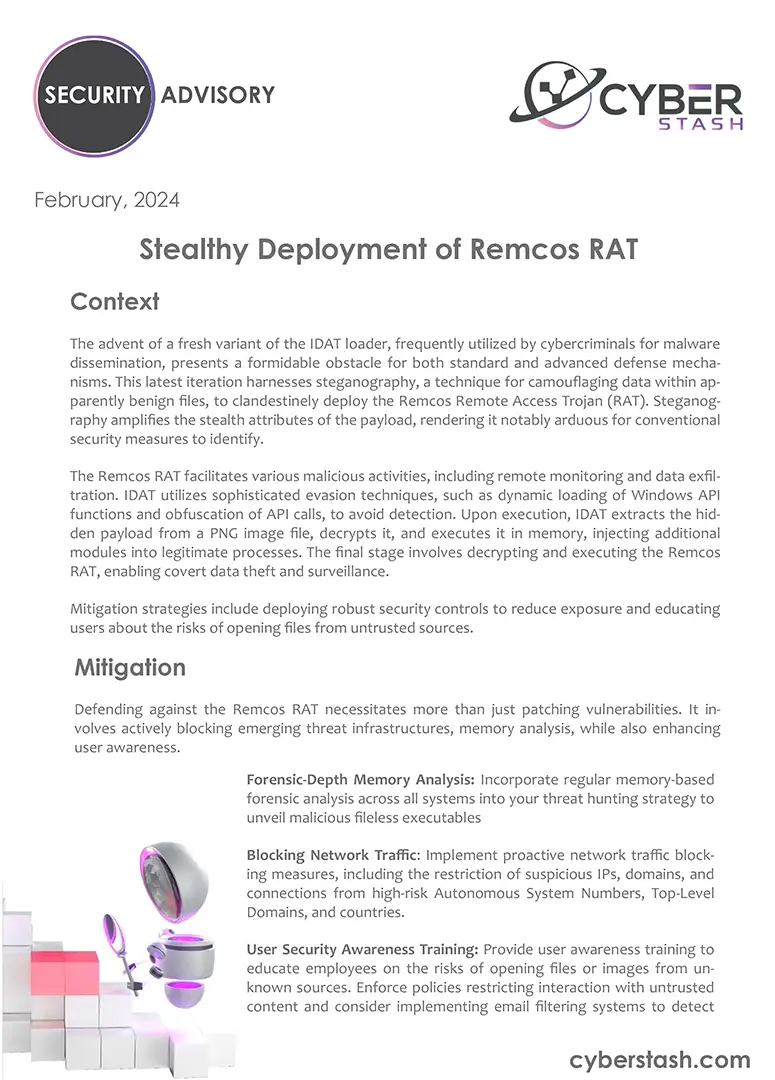Emerging Cyber Threat Reports
Cyber Security Advisories
Scan with Your Phone to Stay Ahead of Threats
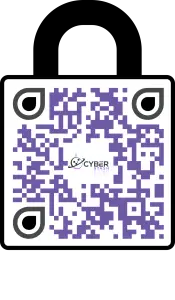
Subscribe to Security Advisories
Stay Ahead of Cyber Threats Get timely security advisories crafted by CyberStash experts. Receive practical insights, emerging threat updates, and actionable steps you can use right away to strengthen defences and reduce risk — so you’re always ahead of attackers.

Join Our Next Cybersecurity Webinar
Stay Ahead of Cyber Threats Hear directly from experts on the latest attack techniques and defence strategies. See real-world demos, learn proven countermeasures, and walk away with practical tactics you can apply immediately to improve your organisation’s resilience.

Download the X-in-XDR Whitepaper
Stay Ahead of Cyber Threats Understand what XDR really means for your business and why traditional tools leave gaps. This whitepaper shows how to close those gaps, measure outcomes, and make smarter security investments — insights every IT and security manager can put to use.
CyberStash Free Monthly Cyber Threat Reports
Each month, CyberStash analyses thousands of threat intelligence sources to spotlight the most significant cyber threat you need to know.
CyberStash 2025 Threat Analysis Report
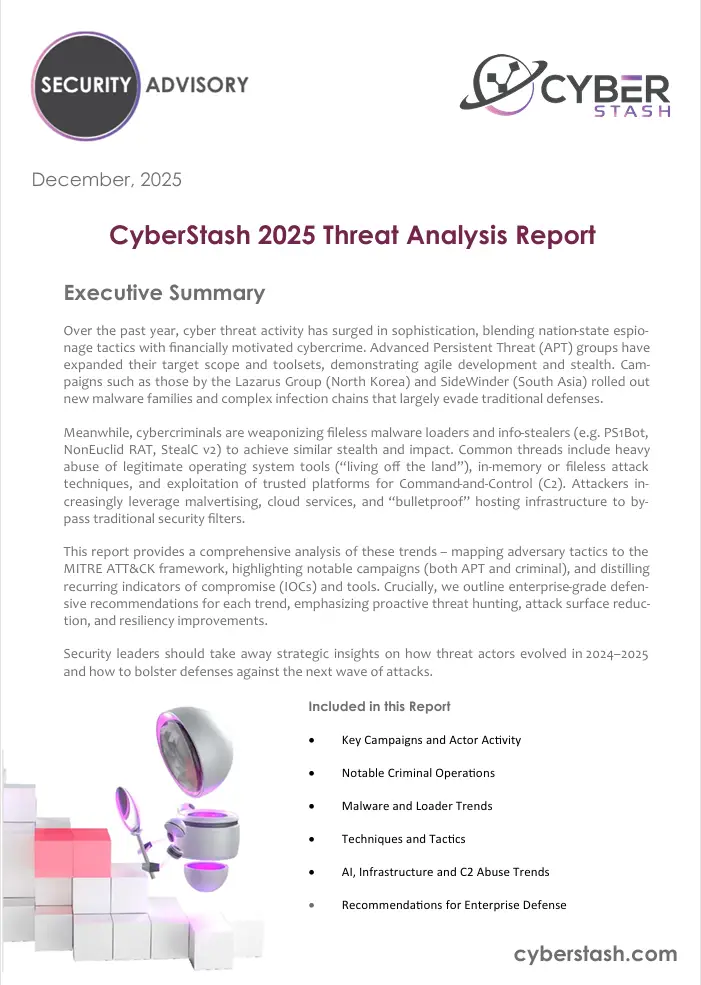
Over the past year, cyber threat activity has surged in both scale and sophistication, blurring the line between nation-state espionage and high-impact cybercrime. Advanced Persistent Threat (APT) groups have expanded their operational reach, unveiling agile, stealthy toolchains and rapidly evolving tactics. Campaigns linked to actors like Lazarus Group (North Korea) and SideWinder (South Asia) deployed novel malware families and multi-stage infection chains that skillfully bypass traditional defenses.
At the same time, cybercriminals are achieving comparable stealth and disruption using advanced fileless loaders and modular info-stealers such as PS1Bot, NonEuclid RAT, and StealC v2. Across both domains, common patterns emerge: aggressive use of “living off the land” techniques, in-memory and fileless execution, and exploitation of trusted platforms for covert Command-and-Control (C2). Adversaries are increasingly leveraging malvertising, cloud infrastructure, and resilient “bulletproof” hosting to sidestep conventional detection.
This report delivers a strategic analysis of these developments—mapping attacker behavior to the MITRE ATT&CK framework, spotlighting significant campaigns, and surfacing recurring indicators of compromise (IOCs) and tooling. Each trend includes enterprise-grade defensive recommendations focused on proactive threat hunting, minimizing attack surfaces, and strengthening cyber resilience.
Security leaders will find forward-looking insights into how adversaries evolved across 2024–2025—and how to harden defenses for the battles ahead.
Included in This Report
• Key Nation-State and Criminal Campaigns
• Emerging Malware and Loader Innovations
• Tactics, Techniques, and Procedures (TTPs)
• AI-Augmented Threat Operations and C2 Abuse
• Strategic Recommendations for Enterprise Defense
BRICKSTORM: Beneath the Security Stack
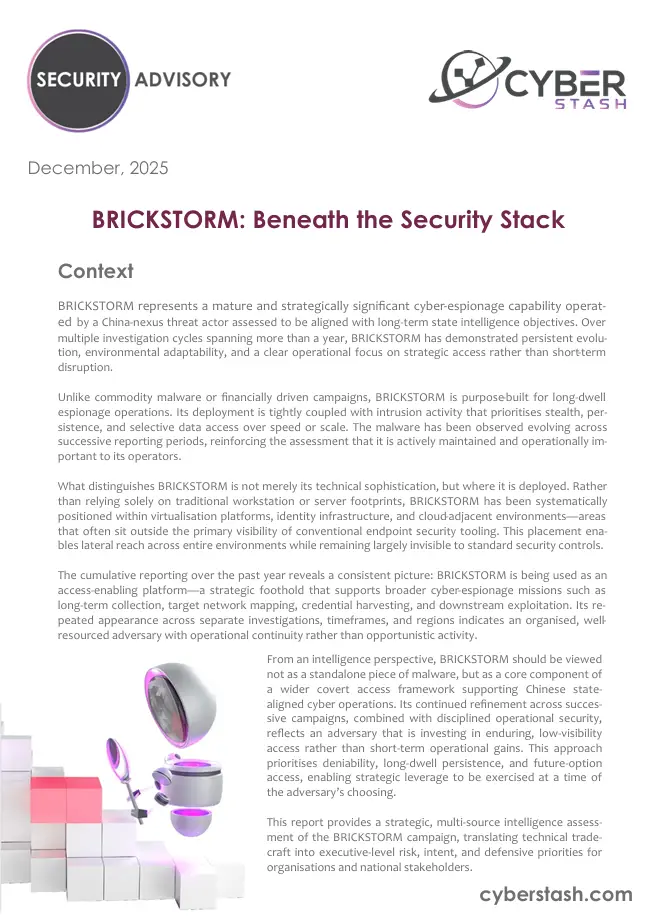
BRICKSTORM is a strategic, state-aligned cyber-espionage capability operated by a China-nexus threat actor focused on long-term access, not short-term disruption. Across multiple investigation cycles, it has shown continuous evolution, environmental adaptability, and a clear bias toward stealth, persistence, and strategic positioning rather than speed or scale.
Unlike commodity malware, BRICKSTORM is purpose-built for long-dwell espionage. It is deliberately embedded within virtualisation platforms, identity infrastructure, and cloud-adjacent control layers—areas that often sit outside the visibility of traditional endpoint security and default SIEM monitoring. This positioning allows lateral control across entire environments while remaining largely unseen.
From an intelligence perspective, BRICKSTORM should be viewed not as a standalone tool, but as a core component of a wider covert access framework supporting Chinese state-aligned cyber operations. Its continued refinement and disciplined operational security reflect an adversary investing in enduring, low-visibility access and future-option strategic leverage, not immediate impact.
This report provides a strategic, multi-source intelligence assessment of the BRICKSTORM campaign, translating adversary tradecraft into executive-level risk, intent, and defensive priorities for organisations and national stakeholders.
China-Linked Espionage Threatening Asia Pacific Critical Communications
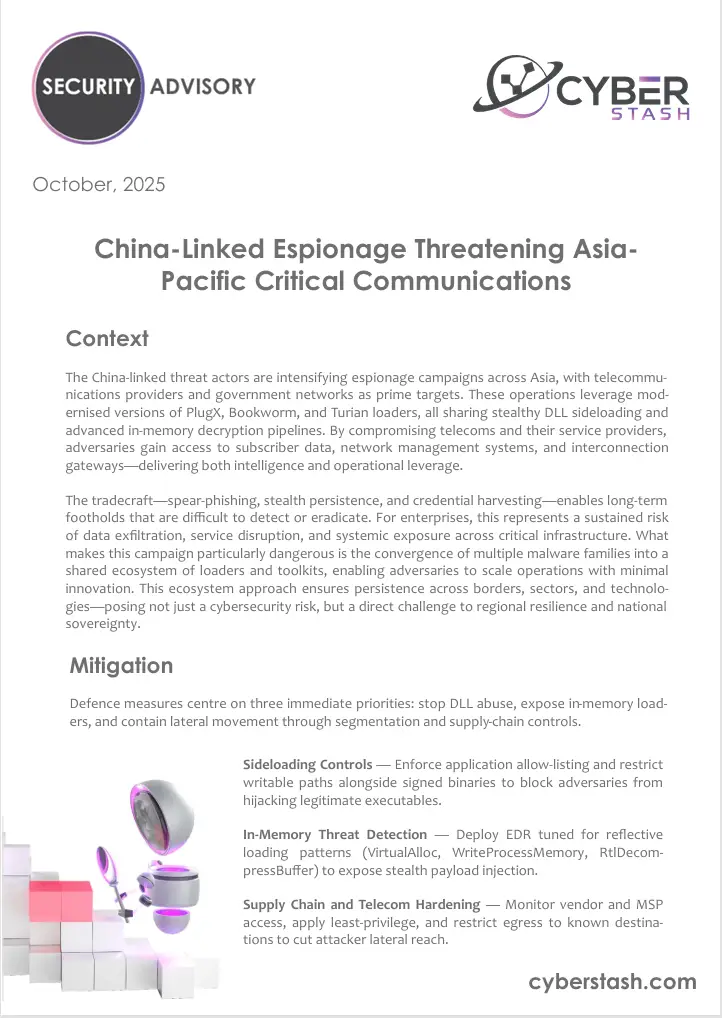
The China-linked threat actors are intensifying espionage campaigns across Asia, with telecommunications providers and government networks as prime targets. These operations leverage modernised versions of PlugX, Bookworm, and Turian loaders, all sharing stealthy DLL sideloading and advanced in-memory decryption pipelines. By compromising telecoms and their service providers, adversaries gain access to subscriber data, network management systems, and interconnection gateways—delivering both intelligence and operational leverage.
The tradecraft—spear-phishing, stealth persistence, and credential harvesting—enables long-term footholds that are difficult to detect or eradicate. For enterprises, this represents a sustained risk of data exfiltration, service disruption, and systemic exposure across critical infrastructure. The convergence of multiple malware families into a shared ecosystem of loaders and toolkits enables adversaries to scale operations with minimal innovation—posing a direct challenge to regional resilience and national sovereignty.
Operation Cartograph: Flax Typhoon’s
ArcGIS Exploitation Campaign
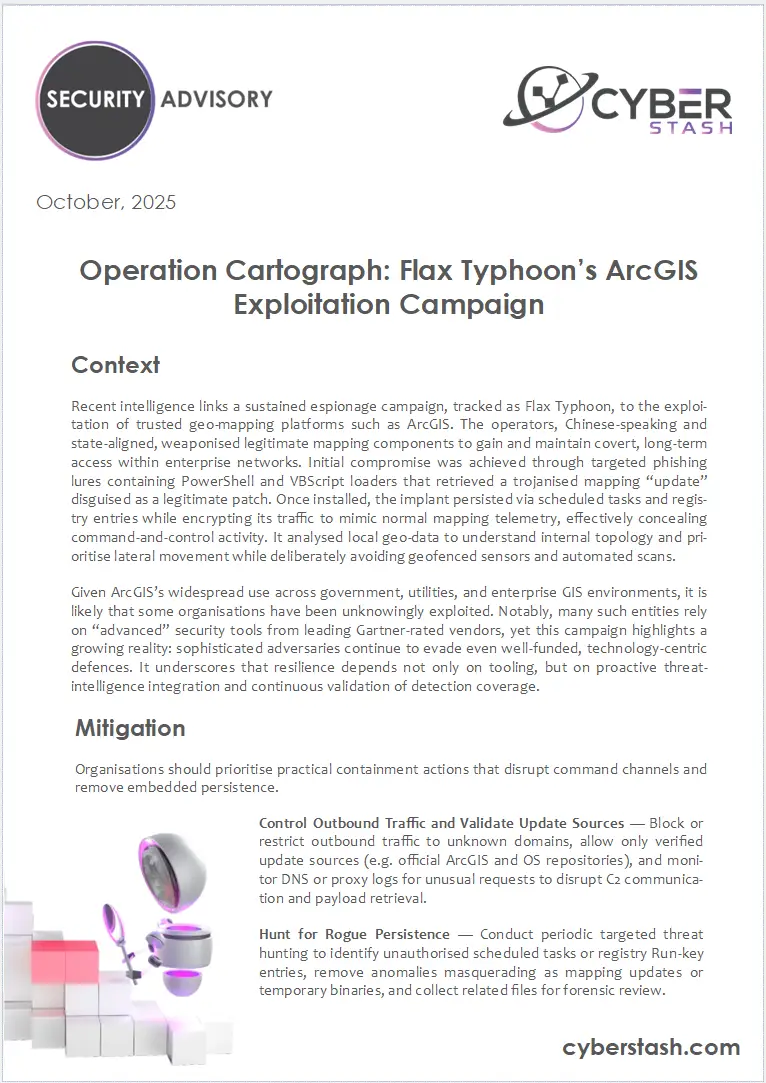
Recent intelligence links a sustained espionage campaign, tracked as Flax Typhoon, to the exploitation of trusted geo-mapping platforms such as ArcGIS. The operators—Chinese-speaking and state-aligned—weaponized legitimate mapping components to gain and maintain covert, long-term access within enterprise networks. Initial compromise occurred through targeted phishing lures containing PowerShell and VBScript loaders, which retrieved a trojanized mapping “update” disguised as a legitimate patch.
Once installed, the implant persisted via scheduled tasks and registry entries, encrypting its traffic to mimic normal mapping telemetry and effectively concealing command-and-control activity. It analyzed local geo-data to understand internal topology and prioritize lateral movement while deliberately avoiding geofenced sensors and automated scans.
Given ArcGIS’s widespread use across government, utilities, and enterprise GIS environments, it is likely that some organizations have been unknowingly exploited. Notably, many of these entities rely on “advanced” security tools from leading Gartner-rated vendors. Yet this campaign highlights a growing reality: sophisticated adversaries continue to evade even well-funded, technology-centric defenses. It underscores that resilience depends not only on tooling, but on proactive threat intelligence integration and continuous validation of detection coverage.
Reducing Exposure to Bulletproof Hosting
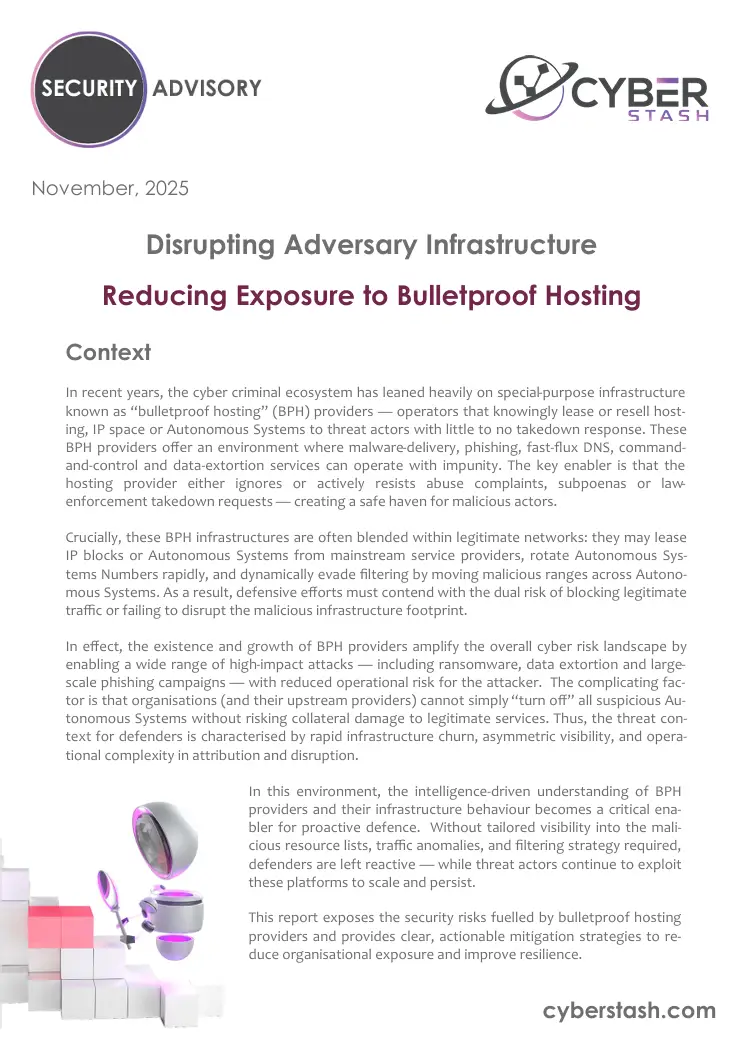
Cybercriminals increasingly rely on “bulletproof hosting” (BPH) providers—services that knowingly lease hosting, IP space, or entire ASNs to threat actors while ignoring abuse complaints and takedown requests. These networks provide a safe haven for malware delivery, phishing, fast-flux DNS, command-and-control, and data-extortion operations.
BPH infrastructure is often blended into legitimate networks, using leased IP blocks and rapidly rotating ASNs to evade detection. This creates a difficult balance for defenders: block too aggressively and risk disrupting legitimate services; block too narrowly and leave malicious infrastructure untouched.
The growth of BPH services amplifies cyber risk by enabling high-impact attacks such as ransomware, large-scale phishing, and data-extortion campaigns with minimal operational cost to attackers. Their constant infrastructure churn, cross-jurisdictional hosting, and opaque ownership make attribution and disruption significantly harder.
In this environment, intelligence-led visibility into BPH infrastructure is essential. Without the ability to identify malicious ASNs, TLDs, and traffic patterns, organisations remain reactive while adversaries exploit resilient hosting to operate at scale.
This report outlines how bulletproof hosting fuels modern cyber threats and provides clear, actionable strategies for reducing organisational exposure and improving resilience.
Lazarus Group Expands Malware Arsenal with New RAT Families
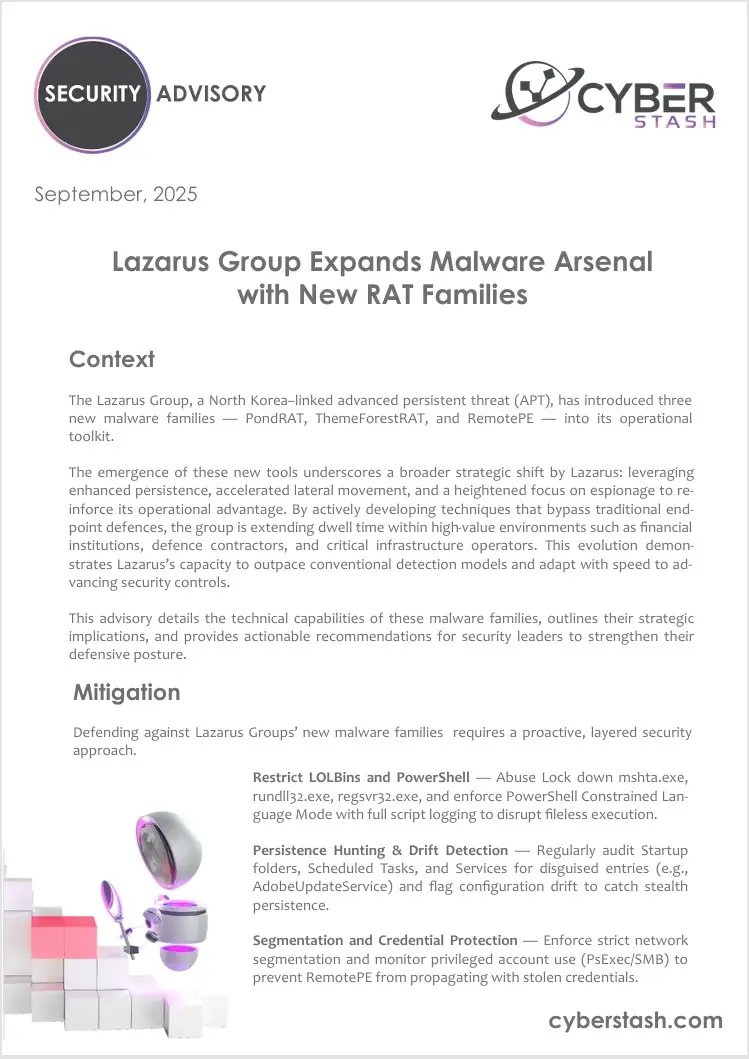
The Lazarus Group, a North Korea–linked advanced persistent threat (APT), has introduced three new malware families — PondRAT, ThemeForestRAT, and RemotePE — into its operational toolkit.
The emergence of these tools underscores a broader strategic shift by Lazarus: leveraging enhanced persistence, accelerated lateral movement, and a heightened focus on espionage to reinforce its operational advantage. By actively developing techniques that bypass traditional endpoint defences, the group is extending dwell time within high-value environments such as financial institutions, defence contractors, and critical infrastructure operators. This evolution demonstrates Lazarus’s capacity to outpace conventional detection models and adapt rapidly to advancing security controls.
This advisory details the technical capabilities of these malware families, outlines their strategic implications, and provides actionable recommendations for security leaders to strengthen their defensive posture.
China-Linked Espionage Threatening Asia Pacific Critical Communications

The China-linked threat actors are intensifying espionage campaigns across Asia, with telecommunications providers and government networks as prime targets. These operations leverage modernised versions of PlugX, Bookworm, and Turian loaders, all sharing stealthy DLL sideloading and advanced in-memory decryption pipelines. By compromising telecoms and their service providers, adversaries gain access to subscriber data, network management systems, and interconnection gateways—delivering both intelligence and operational leverage.
The tradecraft—spear-phishing, stealth persistence, and credential harvesting—enables long-term footholds that are difficult to detect or eradicate. For enterprises, this represents a sustained risk of data exfiltration, service disruption, and systemic exposure across critical infrastructure. The convergence of multiple malware families into a shared ecosystem of loaders and toolkits enables adversaries to scale operations with minimal innovation—posing a direct challenge to regional resilience and national sovereignty.
Operation Cartograph: Flax Typhoon’s
ArcGIS Exploitation Campaign

Recent intelligence links a sustained espionage campaign, tracked as Flax Typhoon, to the exploitation of trusted geo-mapping platforms such as ArcGIS. The operators—Chinese-speaking and state-aligned—weaponized legitimate mapping components to gain and maintain covert, long-term access within enterprise networks. Initial compromise occurred through targeted phishing lures containing PowerShell and VBScript loaders, which retrieved a trojanized mapping “update” disguised as a legitimate patch.
Once installed, the implant persisted via scheduled tasks and registry entries, encrypting its traffic to mimic normal mapping telemetry and effectively concealing command-and-control activity. It analyzed local geo-data to understand internal topology and prioritize lateral movement while deliberately avoiding geofenced sensors and automated scans.
Given ArcGIS’s widespread use across government, utilities, and enterprise GIS environments, it is likely that some organizations have been unknowingly exploited. Notably, many of these entities rely on “advanced” security tools from leading Gartner-rated vendors. Yet this campaign highlights a growing reality: sophisticated adversaries continue to evade even well-funded, technology-centric defenses. It underscores that resilience depends not only on tooling, but on proactive threat intelligence integration and continuous validation of detection coverage.
PS1Bot Loader: Malvertising Meets Memory
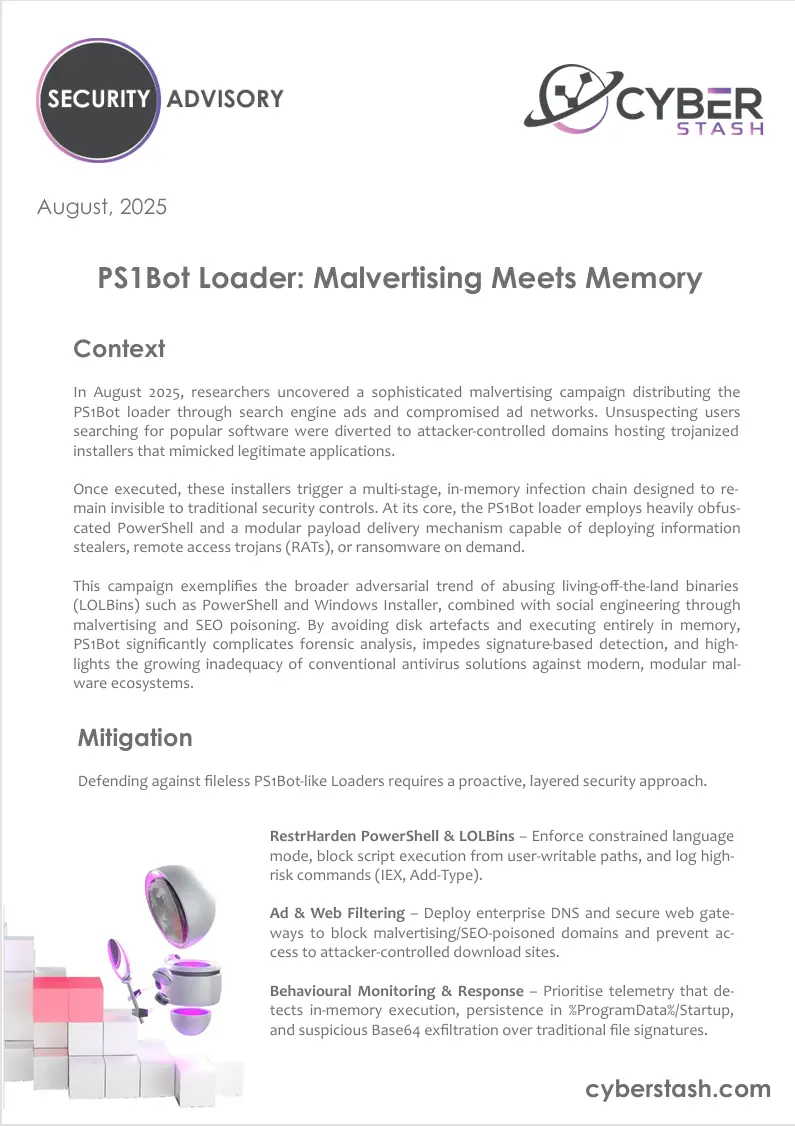
In August 2025, researchers uncovered a sophisticated malvertising campaign distributing the PS1Bot loader through search engine ads and compromised ad networks. Unsuspecting users searching for popular software were diverted to attacker-controlled domains hosting trojanized installers that mimicked legitimate applications.
Once executed, these installers trigger a multi-stage, in-memory infection chain designed to remain invisible to traditional security controls. At its core, the PS1Bot loader employs heavily obfuscated PowerShell and a modular payload delivery mechanism capable of deploying information stealers, remote access trojans (RATs), or ransomware on demand.
This campaign exemplifies the broader adversarial trend of abusing living-off-the-land binaries (LOLBins) such as PowerShell and Windows Installer, combined with social engineering through malvertising and SEO poisoning. By avoiding disk artefacts and executing entirely in memory, PS1Bot significantly complicates forensic analysis, impedes signature-based detection, and highlights the growing inadequacy of conventional antivirus solutions against modern, modular malware ecosystems.
The Defender Deception: How Your Endpoint Security Is Being Outsmarted
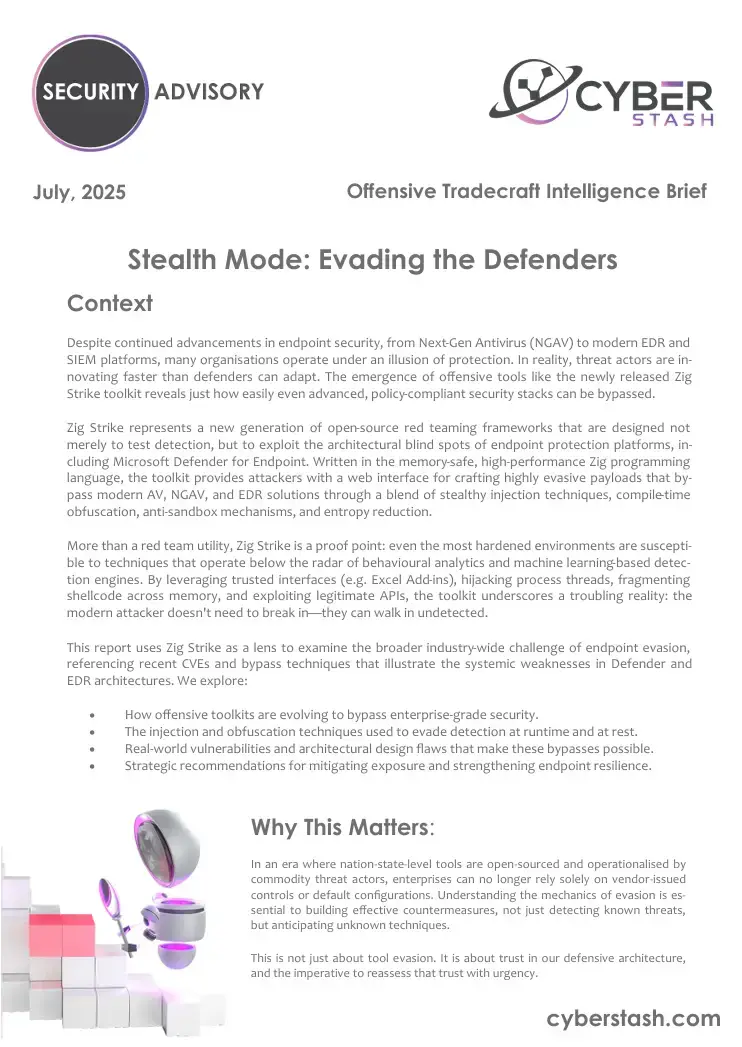
Despite ongoing advancements in endpoint security—from Next-Gen Antivirus (NGAV) to modern EDR and SIEM platforms—many organisations continue to operate under a false sense of protection. In reality, threat actors are innovating faster than defenders can adapt. The recent release of the Zig Strike toolkit highlights how easily even advanced, policy-compliant security stacks can be bypassed.
Zig Strike represents a new breed of open-source red teaming frameworks, purpose-built not only to test detection capabilities but to exploit fundamental blind spots in endpoint protection platforms—including Microsoft Defender for Endpoint. Written in the memory-safe and high-performance Zig programming language, the toolkit enables attackers to craft highly evasive payloads through a web interface. These payloads evade modern AV, NGAV, and EDR tools by combining stealthy injection techniques, compile-time obfuscation, anti-sandbox logic, and entropy suppression.
More than just a red team utility, Zig Strike serves as a stark reminder: even well-defended environments remain vulnerable to techniques that operate beneath the threshold of behavioural analytics and machine learning detection. By abusing trusted execution paths (e.g., Excel Add-ins), hijacking legitimate threads, fragmenting shellcode in memory, and exploiting native APIs, attackers demonstrate a critical truth—modern adversaries don’t need to break in; they can walk in undetected.
This report uses Zig Strike as a lens to explore the broader, systemic challenge of endpoint evasion. We examine:
- The rapid evolution of offensive toolkits designed to defeat enterprise-grade security.
- Injection and obfuscation methods that evade detection both at rest and at runtime.
- Real-world CVEs and architectural flaws that enable these bypasses.
- Strategic recommendations for reducing exposure and strengthening endpoint resilience.
Chrome Zero-Day Exploited in the Wild
Enables Sandbox Escape
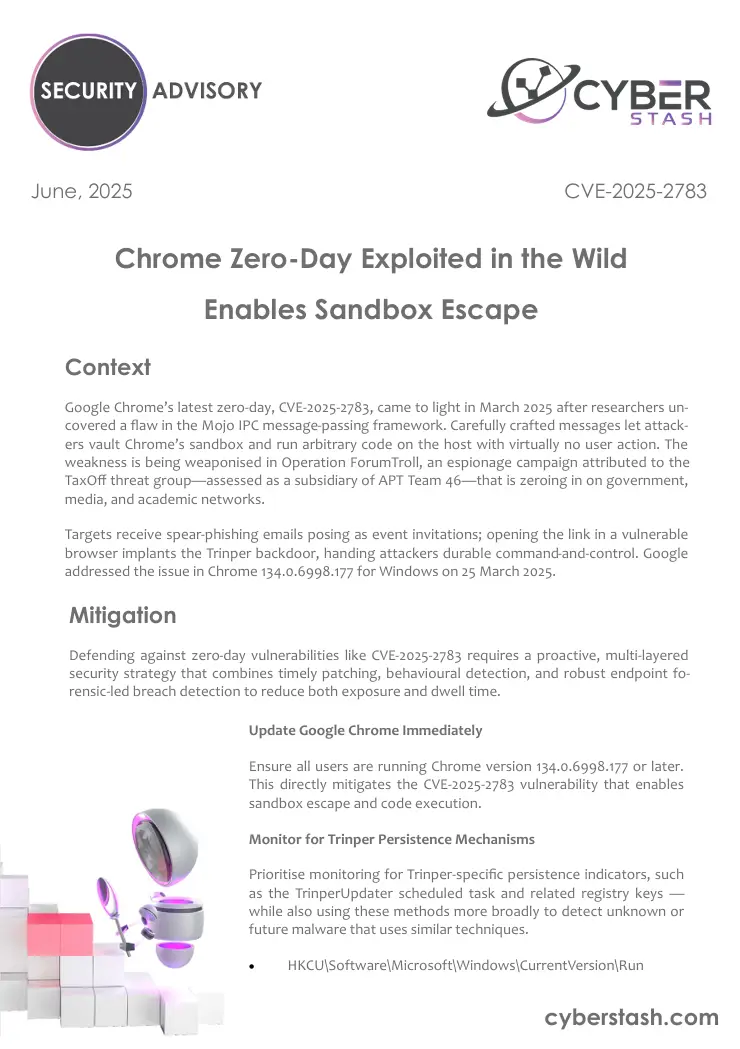
Google Chrome’s latest zero-day, CVE-2025-2783, came to light in March 2025 after researchers uncovered a flaw in the Mojo IPC message-passing framework. Carefully crafted messages let attackers vault Chrome’s sandbox and run arbitrary code on the host with virtually no user action. The weakness is being weaponised in Operation ForumTroll, an espionage campaign attributed to the TaxOff threat group—assessed as a subsidiary of APT Team 46—that is zeroing in on government, media, and academic networks.
Targets receive spear-phishing emails posing as event invitations; opening the link in a vulnerable browser implants the Trinper backdoor, handing attackers durable command-and-control. Google addressed the issue in Chrome 134.0.6998.177 for Windows on 25 March 2025.
Fileless, Fearless, and in Your Network – The 2025 Remcos RAT Surge
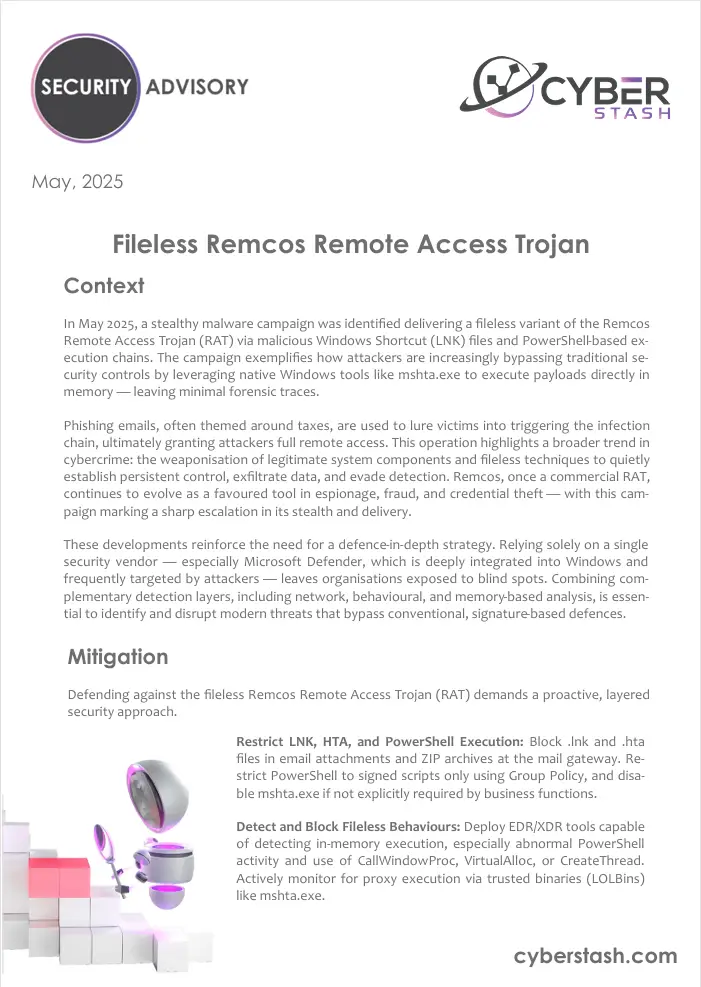
In May 2025, a stealthy malware campaign was identified delivering a fileless variant of the Remcos Remote Access Trojan (RAT) via malicious Windows Shortcut (LNK) files and PowerShell-based execution chains. The campaign exemplifies how attackers are increasingly bypassing traditional security controls by leveraging native Windows tools like <code>mshta.exe</code> to execute payloads directly in memory — leaving minimal forensic traces.
Phishing emails, often themed around taxes, are used to lure victims into triggering the infection chain, ultimately granting attackers full remote access. This operation highlights a broader trend in cybercrime: the weaponisation of legitimate system components and fileless techniques to quietly establish persistent control, exfiltrate data, and evade detection. Remcos, once a commercial RAT, continues to evolve as a favoured tool in espionage, fraud, and credential theft — with this campaign marking a sharp escalation in its stealth and delivery.
These developments reinforce the need for a defence-in-depth strategy. Relying solely on a single security vendor — especially Microsoft Defender, which is deeply integrated into Windows and frequently targeted by attackers — leaves organisations exposed to blind spots. Combining complementary detection layers, including network, behavioural, and memory-based analysis, is essential to identify and disrupt modern threats that bypass conventional, signature-based defences.
The Rise of StealC v2
Silent, Modular, Dangerous
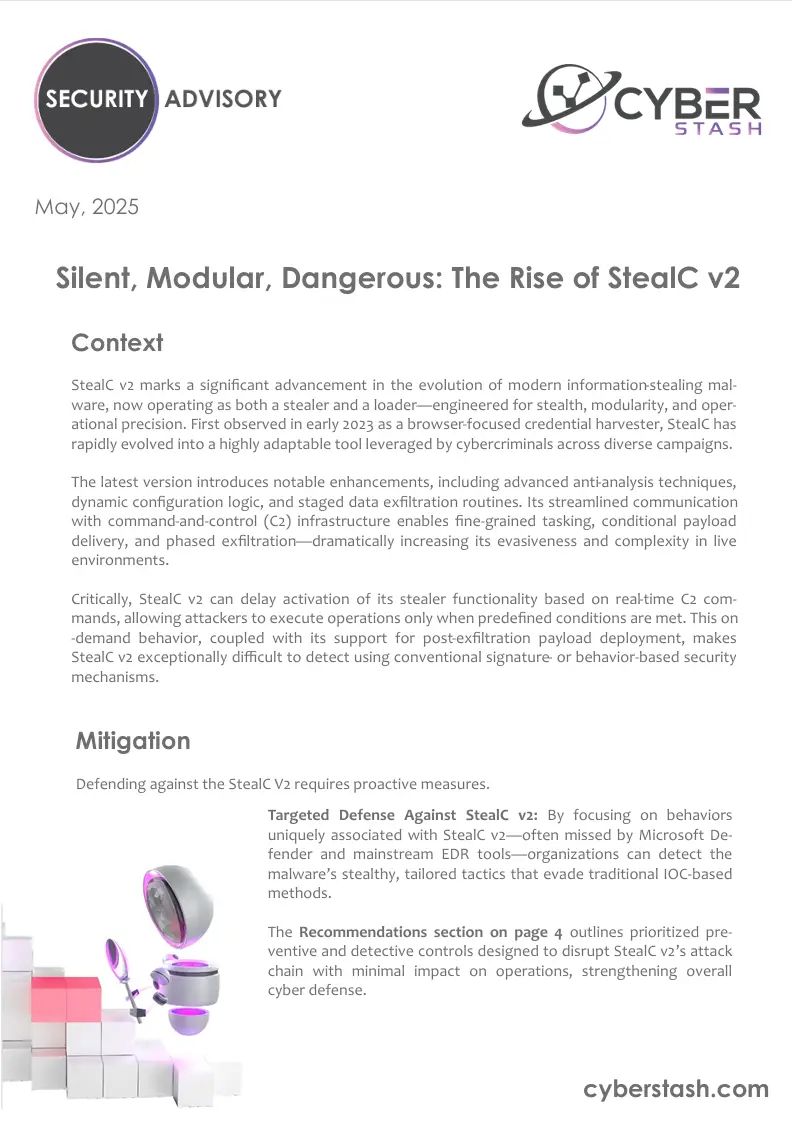
StealC v2 marks a significant advancement in the evolution of modern information-stealing mal ,o9ware, now operating as both a stealer and a loader—engineered for stealth, modularity, and operational precision. First observed in late 2022 as a browser-focused credential harvester, StealC has rapidly evolved into a highly adaptable tool leveraged by cybercriminals across diverse campaigns.
The latest version introduces notable enhancements, including advanced anti-analysis techniques, dynamic configuration logic, and staged data exfiltration routines. Its streamlined communication with command-and-control (C2) infrastructure enables fine-grained tasking, conditional payload delivery, and phased exfiltration—dramatically increasing its evasiveness and complexity in live environments.
Critically, StealC v2 can delay activation of its stealer functionality based on real-time C2 commands, allowing attackers to execute operations only when predefined conditions are met. This on-demand behavior, coupled with its support for post-exfiltration payload deployment, makes StealC v2 exceptionally difficult to detect using conventional signature- or behavior-based security mechanisms.
Evasive Malware Trends
Hijack Loader and SHELBY Campaigns
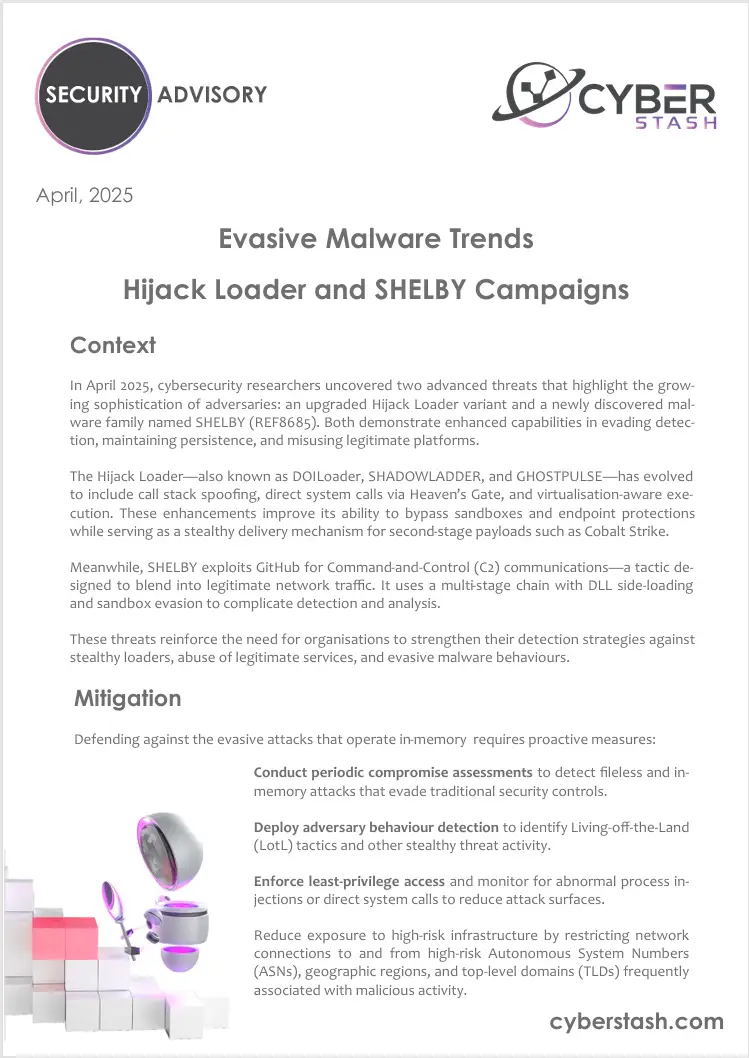
In April 2025, cybersecurity researchers uncovered two advanced threats that highlight the growing sophistication of adversaries: an upgraded Hijack Loader variant and a newly discovered malware family named SHELBY (REF8685). Both demonstrate enhanced capabilities in evading detection, maintaining persistence, and misusing legitimate platforms.
The Hijack Loader—also known as DOILoader, SHADOWLADDER, and GHOSTPULSE—has evolved to include call stack spoofing, direct system calls via Heaven’s Gate, and virtualisation-aware execution. These enhancements improve its ability to bypass sandboxes and endpoint protections while serving as a stealthy delivery mechanism for second-stage payloads such as Cobalt Strike.
Meanwhile, SHELBY exploits GitHub for Command-and-Control (C2) communications—a tactic designed to blend into legitimate network traffic. It uses a multi-stage chain with DLL side-loading and sandbox evasion to complicate detection and analysis.
These threats reinforce the need for organisations to strengthen their detection strategies against stealthy loaders, abuse of legitimate services, and evasive malware behaviours.
SideWinder APT
Agile Retool and Evolving Tactics

SideWinder APT — also referred to as APT-C-17, Baby Elephant, Hardcore Nationalist, Leafperforator, Rattlesnake, Razor Tiger, or T-APT-04—has been operational since at least 2012 and continues to demonstrate a high degree of operational maturity, adaptability, and strategic intent. While historically focused on military and government entities in South Asia, SideWinder has significantly broadened its target profile over the past year. This expansion has seen aggressive campaigns against logistics firms, maritime infrastructure, diplomatic missions, and, more recently, nuclear energy organisations—spanning across South and Southeast Asia, the Middle East, and Africa.
These campaigns have employed refined spear-phishing techniques, leveraged well-known but still effective vulnerabilities such as CVE-2017-11882, CVE-2025-2783, and deployed bespoke implants designed for stealth and persistence within critical environments.
The targeting of maritime and nuclear infrastructure—combined with post-compromise activity that includes tailored malware deployment and advanced evasion tactics—suggests an intelligence-driven campaign with strategic geopolitical objectives. The group’s ability to retool within hours of detection, coupled with its use of complex infection chains and memory-resident payloads, reflects a threat actor that is not only technically sophisticated but also operationally agile.
FatalRAT
Targeting Chinese-Speaking Regions
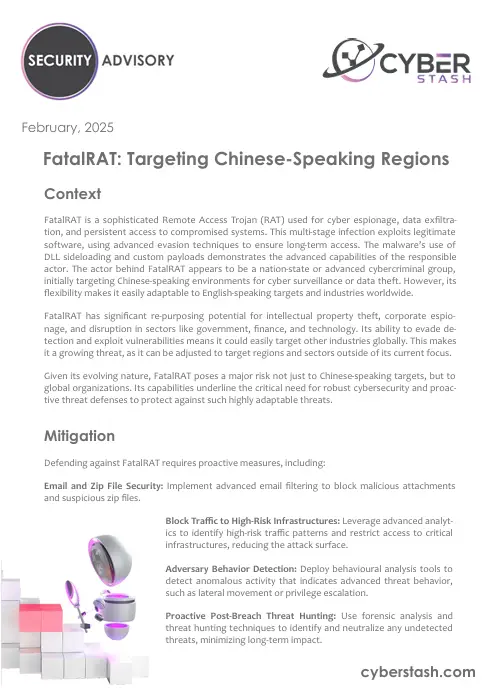
FatalRAT is a sophisticated Remote Access Trojan (RAT) used for cyber espionage, data exfiltration, and persistent access to compromised systems. This multi-stage infection exploits legitimate software, using advanced evasion techniques to ensure long-term access. The malware’s use of DLL sideloading and custom payloads demonstrates the advanced capabilities of the responsible actor. The actor behind FatalRAT appears to be a nation-state or advanced cybercriminal group, initially targeting Chinese-speaking environments for cyber surveillance or data theft. However, its flexibility makes it easily adaptable to English-speaking targets and industries worldwide.
FatalRAT has significant re-purposing potential for intellectual property theft, corporate espionage, and disruption in sectors like government, finance, and technology. Its ability to evade detection and exploit vulnerabilities means it could easily target other industries globally. This makes it a growing threat, as it can be adjusted to target regions and sectors outside of its current focus.
Given its evolving nature, FatalRAT poses a major risk not just to Chinese-speaking targets, but to global organizations. Its capabilities underline the critical need for robust cybersecurity and proactive threat defenses to protect against such highly adaptable threats.
Xiū gǒu
Phishing Kit
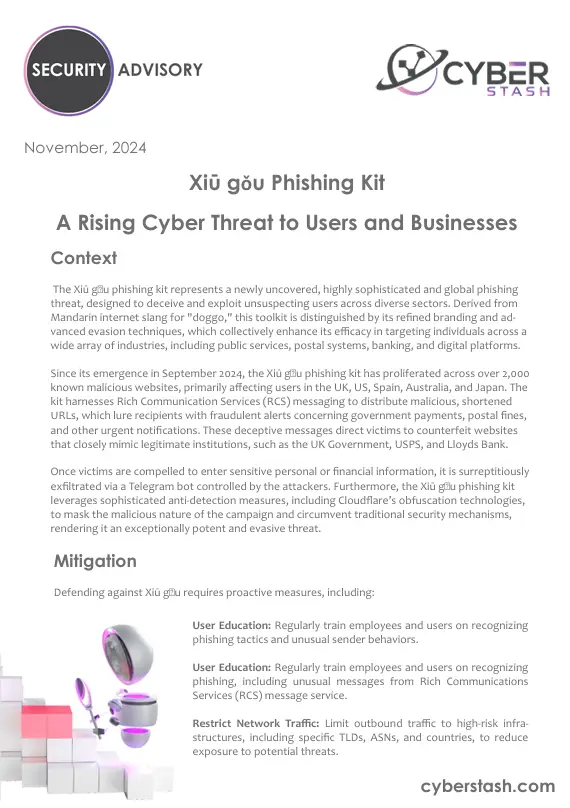
The Xiū gǒu phishing kit represents a newly uncovered, highly sophisticated and global phishing threat, designed to deceive and exploit unsuspecting users across diverse sectors. Derived from Mandarin internet slang for “doggo,” this toolkit is distinguished by its refined branding and advanced evasion techniques, which collectively enhance its efficacy in targeting individuals across a wide array of industries, including public services, postal systems, banking, and digital platforms. Since its emergence in September 2024, the Xiū gǒu phishing kit has proliferated across over 2,000 known malicious websites, primarily affecting users in the UK, US, Spain, Australia, and Japan. The kit harnesses Rich Communication Services (RCS) messaging to distribute malicious, shortened URLs, which lure recipients with fraudulent alerts concerning government payments, postal fines, and other urgent notifications. These deceptive messages direct victims to counterfeit websites that closely mimic legitimate institutions, such as the UK Government, USPS, and Lloyds Bank. Once victims are compelled to enter sensitive personal or financial information, it is surreptitiously exfiltrated via a Telegram bot controlled by the attackers. Furthermore, the Xiū gǒu phishing kit leverages sophisticated anti-detection measures, including Cloudflare’s obfuscation technologies, to mask the malicious nature of the campaign and circumvent traditional security mechanisms, rendering it an exceptionally potent and evasive threat.
Corrupted ZIPs and Office Docs Bypass Security
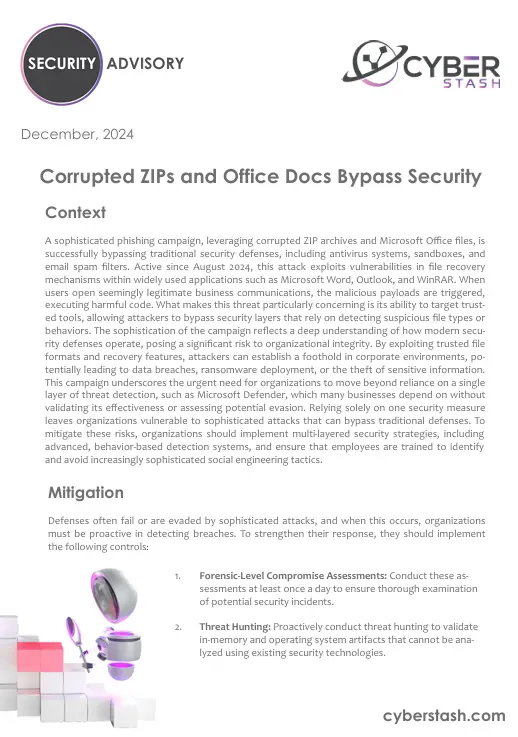
A sophisticated phishing campaign, leveraging corrupted ZIP archives and Microsoft Office files, is successfully bypassing traditional security defenses, including antivirus systems, sandboxes, and email spam filters. Active since August 2024, this attack exploits vulnerabilities in file recovery mechanisms within widely used applications such as Microsoft Word, Outlook, and WinRAR. When users open seemingly legitimate business communications, the malicious payloads are triggered, executing harmful code. What makes this threat particularly concerning is its ability to target trusted tools, allowing attackers to bypass security layers that rely on detecting suspicious file types or behaviors. The sophistication of the campaign reflects a deep understanding of how modern security defenses operate, posing a significant risk to organizational integrity. By exploiting trusted file formats and recovery features, attackers can establish a foothold in corporate environments, potentially leading to data breaches, ransomware deployment, or the theft of sensitive information. This campaign underscores the urgent need for organizations to move beyond reliance on a single layer of threat detection, such as Microsoft Defender, which many businesses depend on without validating its effectiveness or assessing potential evasion. Relying solely on one security measure leaves organizations vulnerable to sophisticated attacks that can bypass traditional defenses. To mitigate these risks, organizations should implement multi-layered security strategies, including advanced, behavior-based detection systems, and ensure that employees are trained to identify and avoid increasingly sophisticated social engineering tactics.
NonEuclid
Remote Access Trojan (RAT)
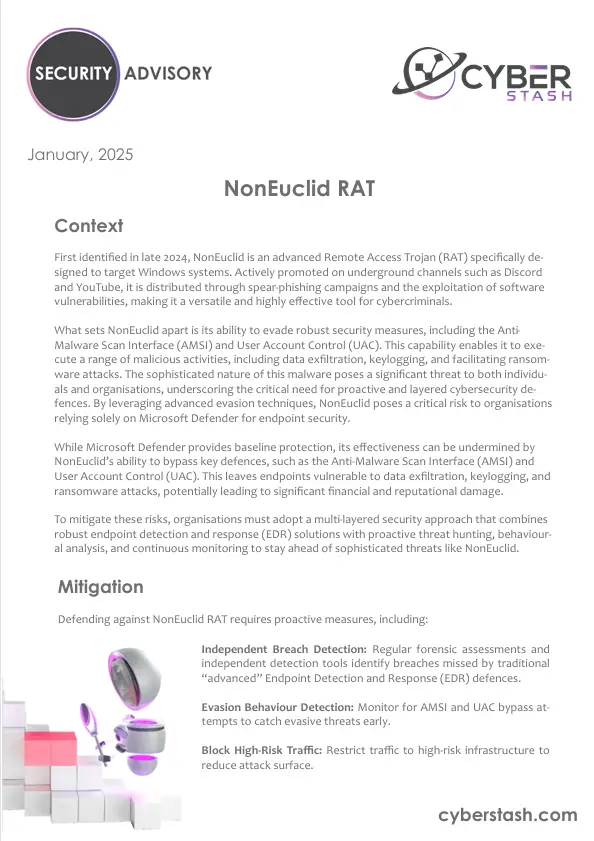
First identified in late 2024, NonEuclid is an advanced Remote Access Trojan (RAT) specifically designed to target Windows systems. Actively promoted on underground channels such as Discord and YouTube, it is distributed through spear-phishing campaigns and the exploitation of software vulnerabilities, making it a versatile and highly effective tool for cybercriminals.
What sets NonEuclid apart is its ability to evade robust security measures, including the Anti-Malware Scan Interface (AMSI) and User Account Control (UAC). This capability enables it to execute a range of malicious activities, including data exfiltration, keylogging, and facilitating ransomware attacks. The sophisticated nature of this malware poses a significant threat to both individuals and organisations, underscoring the critical need for proactive and layered cybersecurity defences. By leveraging advanced evasion techniques, NonEuclid poses a critical risk to organisations relying solely on Microsoft Defender for endpoint security.
While Microsoft Defender provides baseline protection, its effectiveness can be undermined by NonEuclid’s ability to bypass key defences, such as the Anti-Malware Scan Interface (AMSI) and User Account Control (UAC). This leaves endpoints vulnerable to data exfiltration, keylogging, and ransomware attacks, potentially leading to significant financial and reputational damage.
To mitigate these risks, organisations must adopt a multi-layered security approach that combines robust endpoint detection and response (EDR) solutions with proactive threat hunting, behavioural analysis, and continuous monitoring to stay ahead of sophisticated threats like NonEuclid.
Silent Lynx
An Emerging APT Group
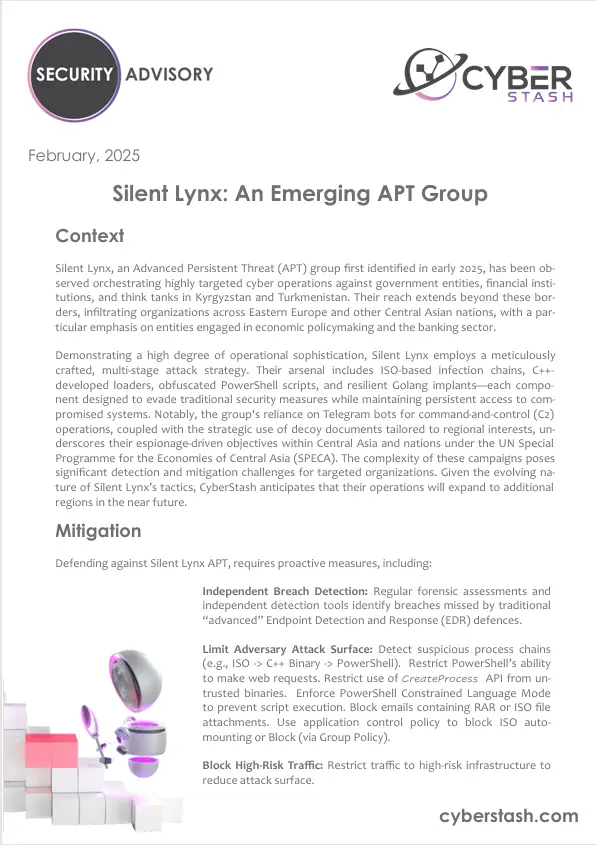
Silent Lynx, an Advanced Persistent Threat (APT) group first identified in early 2025, has been observed orchestrating highly targeted cyber operations against government entities, financial institutions, and think tanks in Kyrgyzstan and Turkmenistan. Their reach extends beyond these borders, infiltrating organizations across Eastern Europe and other Central Asian nations, with a par ticular emphasis on entities engaged in economic policymaking and the banking sector.
Demonstrating a high degree of operational sophistication, Silent Lynx employs a meticulouslycrafted, multi-stage attack strategy. Their arsenal includes ISO-based infection chains, C++ developed loaders, obfuscated PowerShell scripts, and resilient Golang implants—each component designed to evade traditional security measures while maintaining persistent access to compromised systems.
Notably, the group’s reliance on Telegram bots for command-and-control (C2) operations, coupled with the strategic use of decoy documents tailored to regional interests, underscores their espionage-driven objectives within Central Asia and nations under the UN Special Programme for the Economies of Central Asia (SPECA). The complexity of these campaigns poses significant detection and mitigation challenges for targeted organizations. Given the evolving nature of Silent Lynx’s tactics, CyberStash anticipates that their operations will expand to additional regions in the near future.
Pygmy Goat
Malware
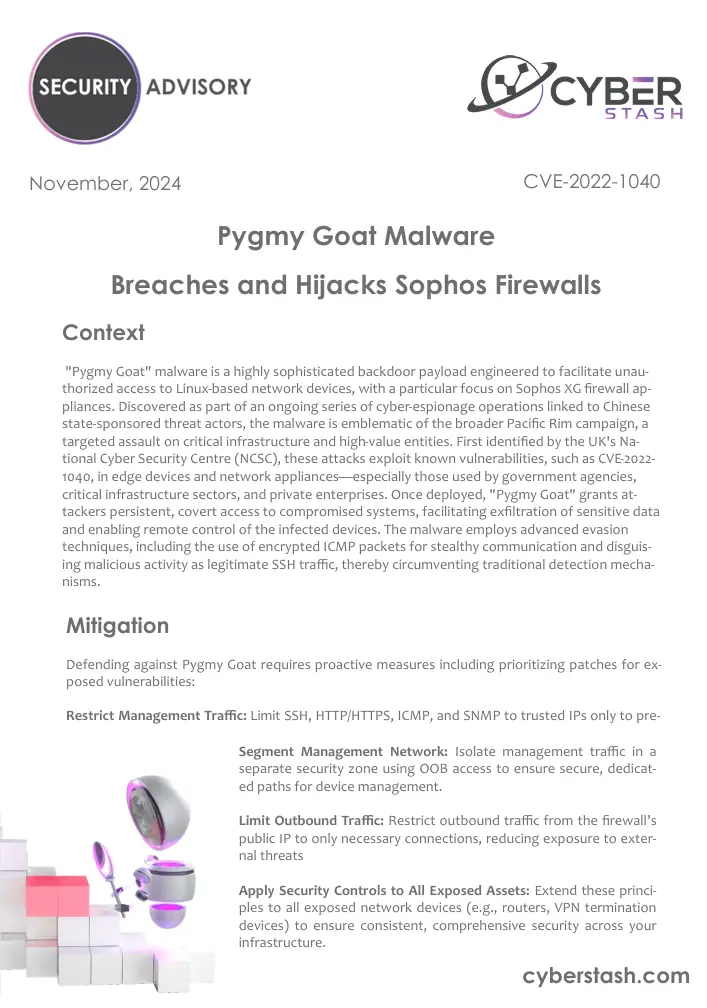
“Pygmy Goat” malware is a highly sophisticated backdoor payload designed to provide unauthorized access to Linux-based network devices, with a particular focus on Sophos XG firewall appliances. Discovered as part of an ongoing series of cyber-espionage operations linked to Chinese state-sponsored threat actors, the malware is emblematic of the broader Pacific Rim campaign—a targeted assault on critical infrastructure and high-value entities. First identified by the UK’s National Cyber Security Centre (NCSC), these attacks exploit known vulnerabilities, such as CVE-2022-1040, in edge devices and network appliances, particularly those used by government agencies, critical infrastructure sectors, and private enterprises. Once deployed, “Pygmy Goat” grants attackers persistent, covert access to compromised systems, enabling the exfiltration of sensitive data and remote control of infected devices. The malware employs advanced evasion techniques, including the use of encrypted ICMP packets for stealthy communication and disguising malicious activity as legitimate SSH traffic, thereby circumventing traditional detection mechanisms
North Korean
Linked MISTPEN Malware
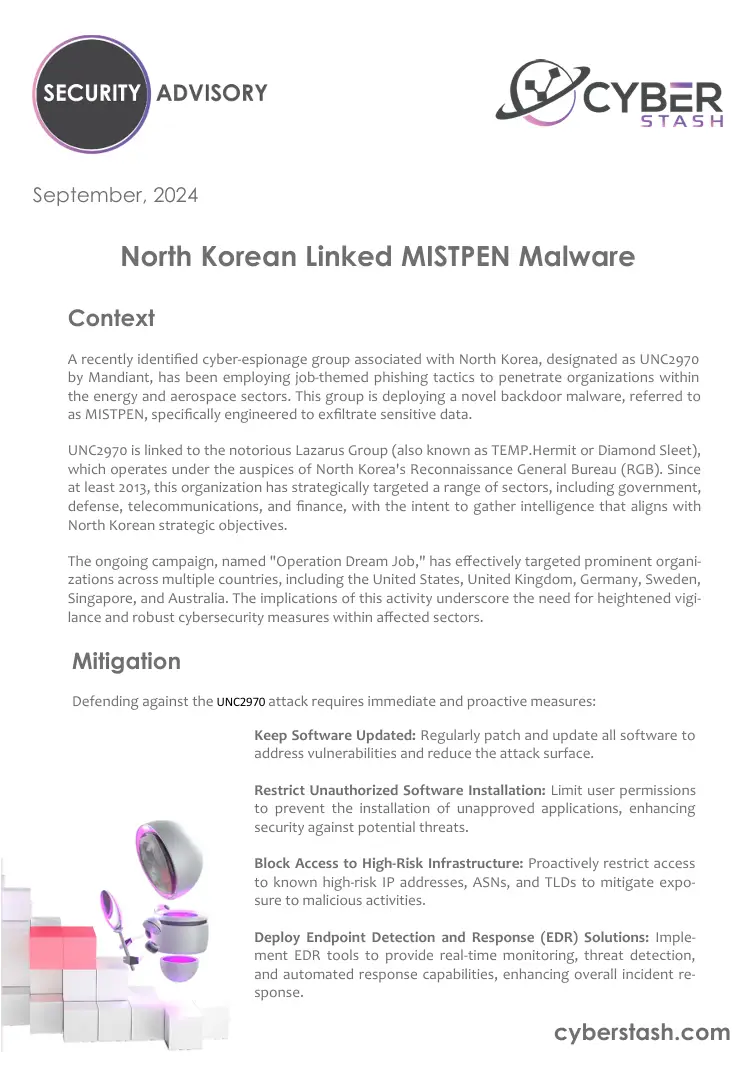
Latrodectus Malware
The Black Widow Threat
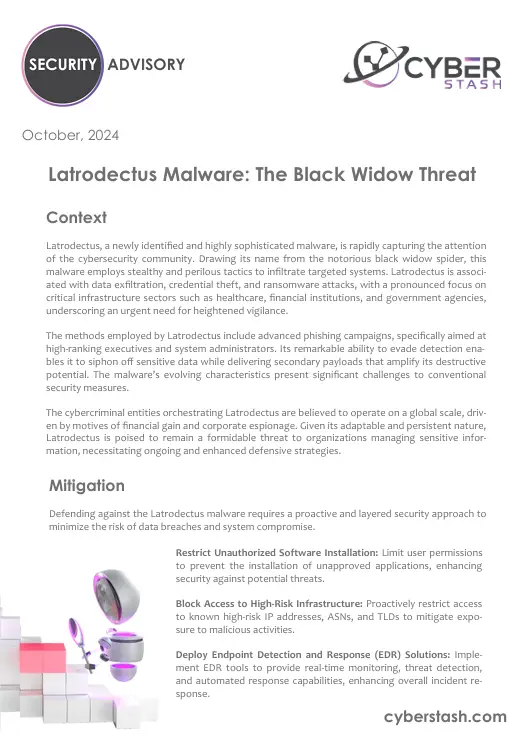
SideWinder APT
StealerBot Campaign
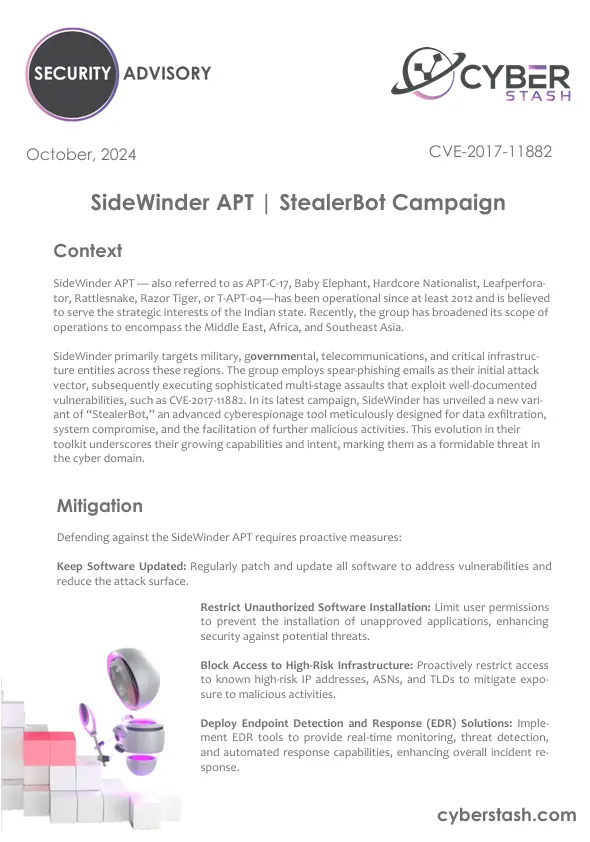
SideWinder APT—also known as APT-C-17, Baby Elephant, Hardcore Nationalist, Leafperforator, Rattlesnake, Razor Tiger, or T-APT-04—has been active since at least 2012 and is believed to support the strategic interests of the Indian state. Recently, the group has expanded its operations to include the Middle East, Africa, and Southeast Asia.
SideWinder primarily targets military, governmental, telecommunications, and critical infrastructure entities in these regions. The group typically initiates attacks through spear-phishing emails, followed by sophisticated multi-stage assaults that exploit well-documented vulnerabilities, such as CVE-2017-11882.
In its latest campaign, SideWinder has introduced a new variant of “StealerBot,” an advanced cyberespionage tool designed for data exfiltration, system compromise, and the facilitation of additional malicious activities. This evolution in their toolkit highlights their growing capabilities and intent, positioning them as a significant threat in the cyber landscape.
Neutralizing Russian
Military Cyber Threats
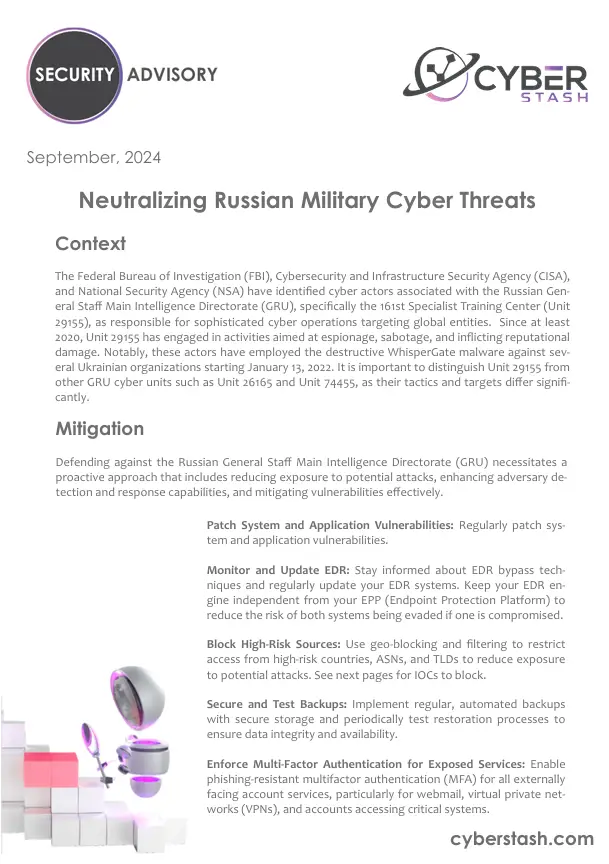
Security Advisory -
VectorStealer Malware
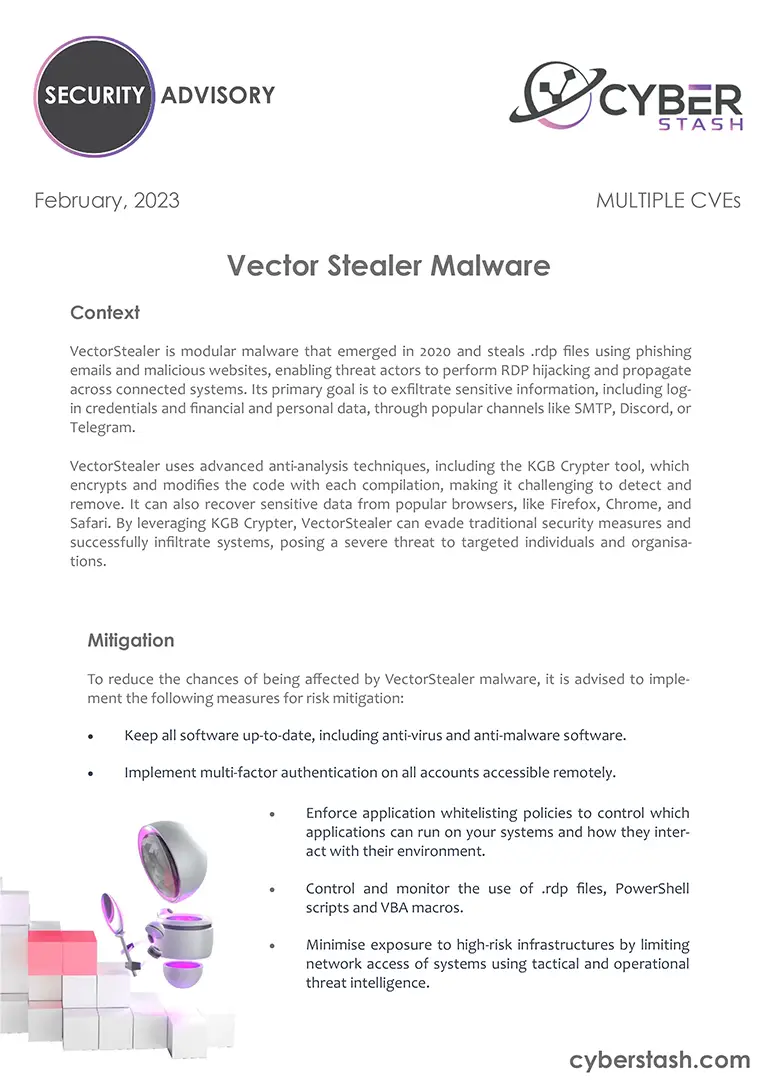
Security Advisory -
Snake Implant Malware
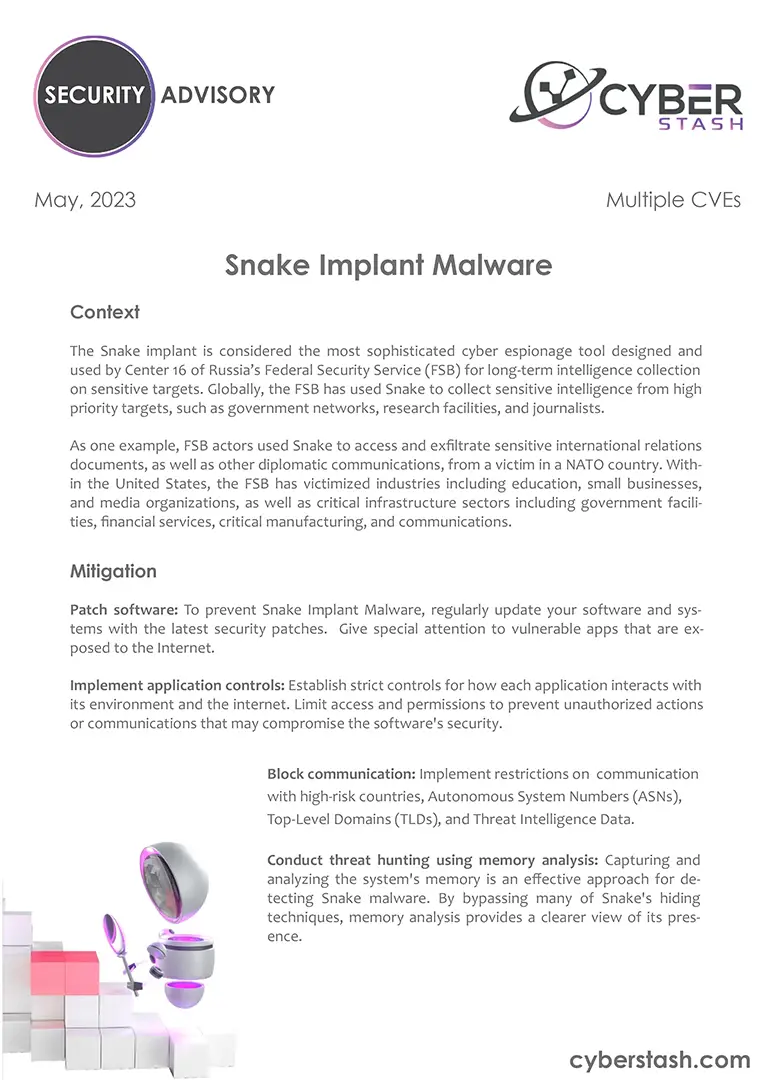
Cicada3301: A Cross-Platform
Rust-Based Ransomware
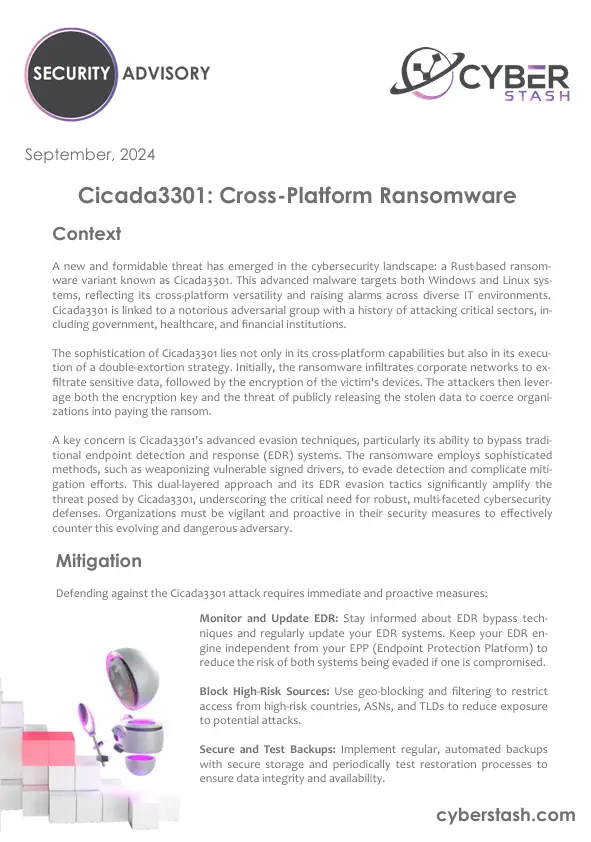
CrowdStrike
Fallout
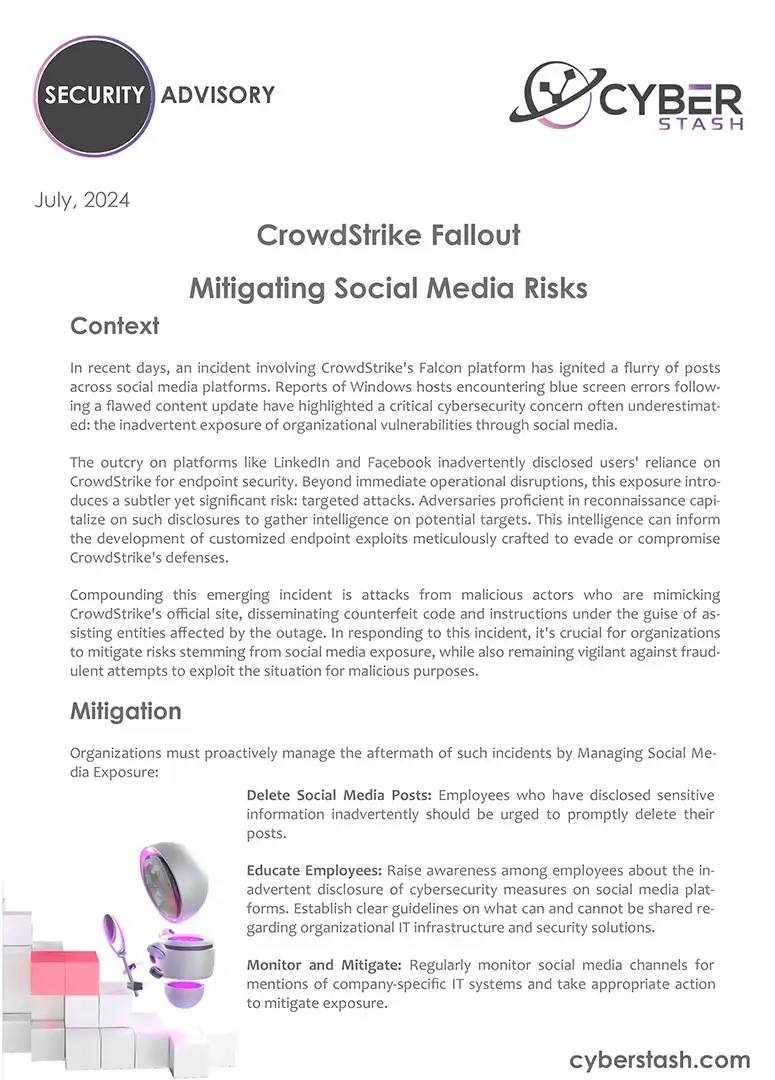
CyberStash Security Advisory -
Lockbit 3.0 Ransomware
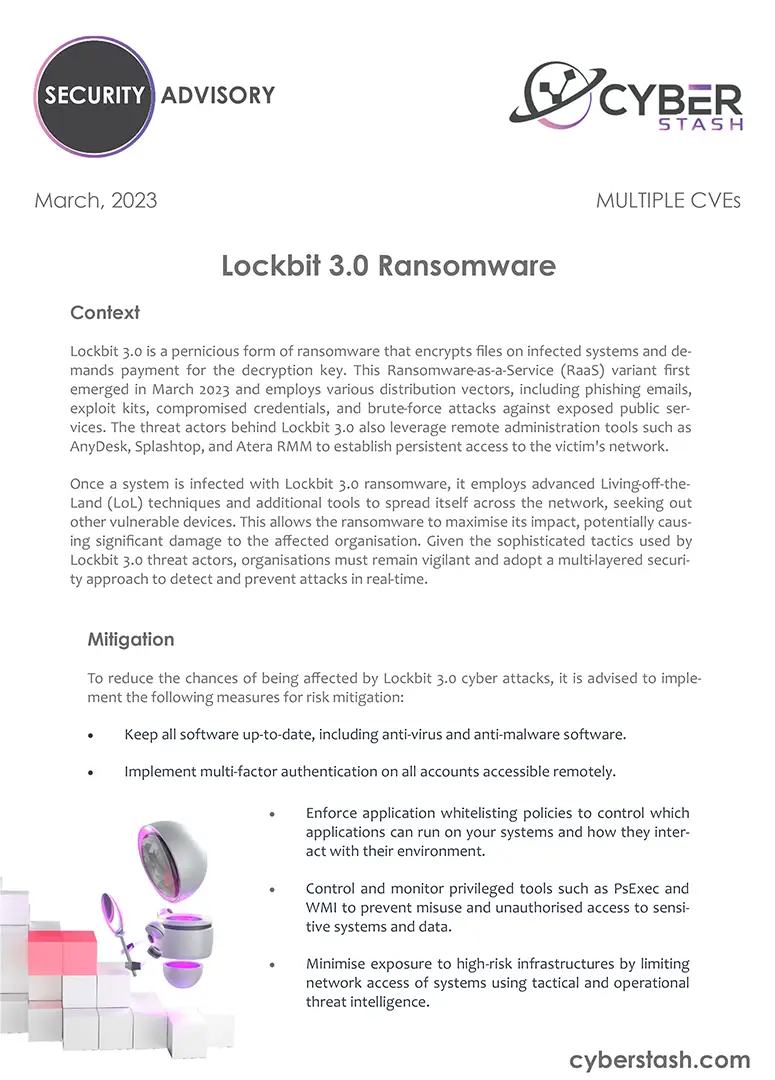
Cuttlefish
Malware
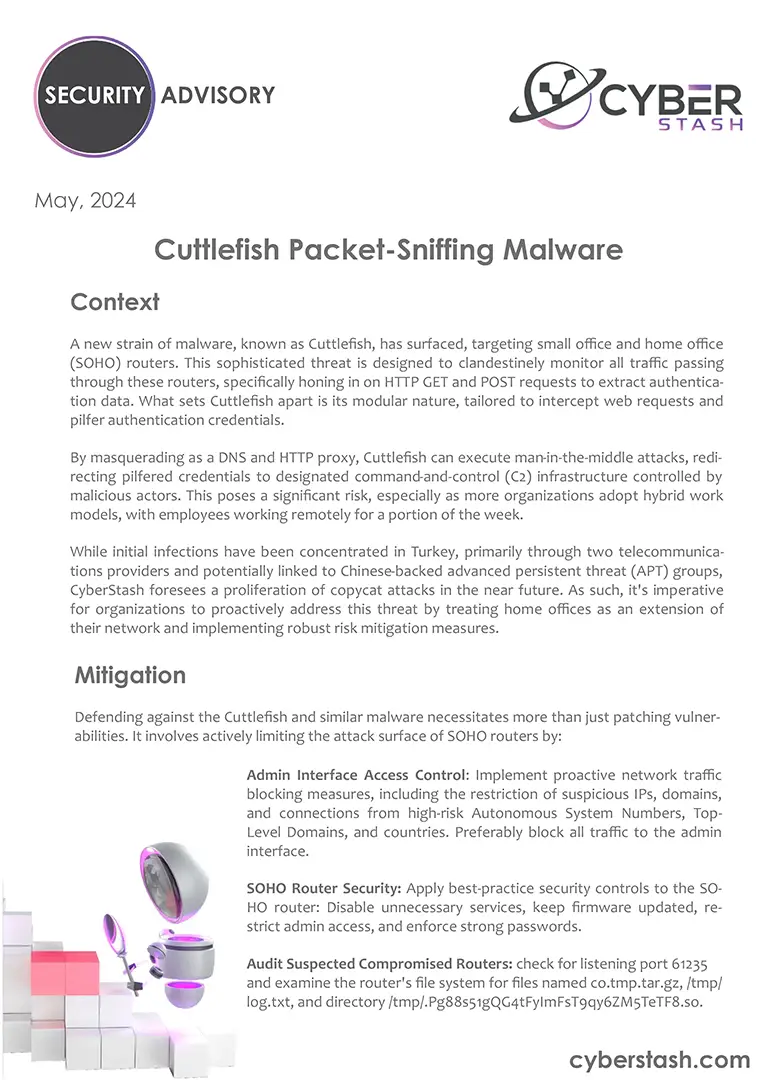
Deadglyph
Malware
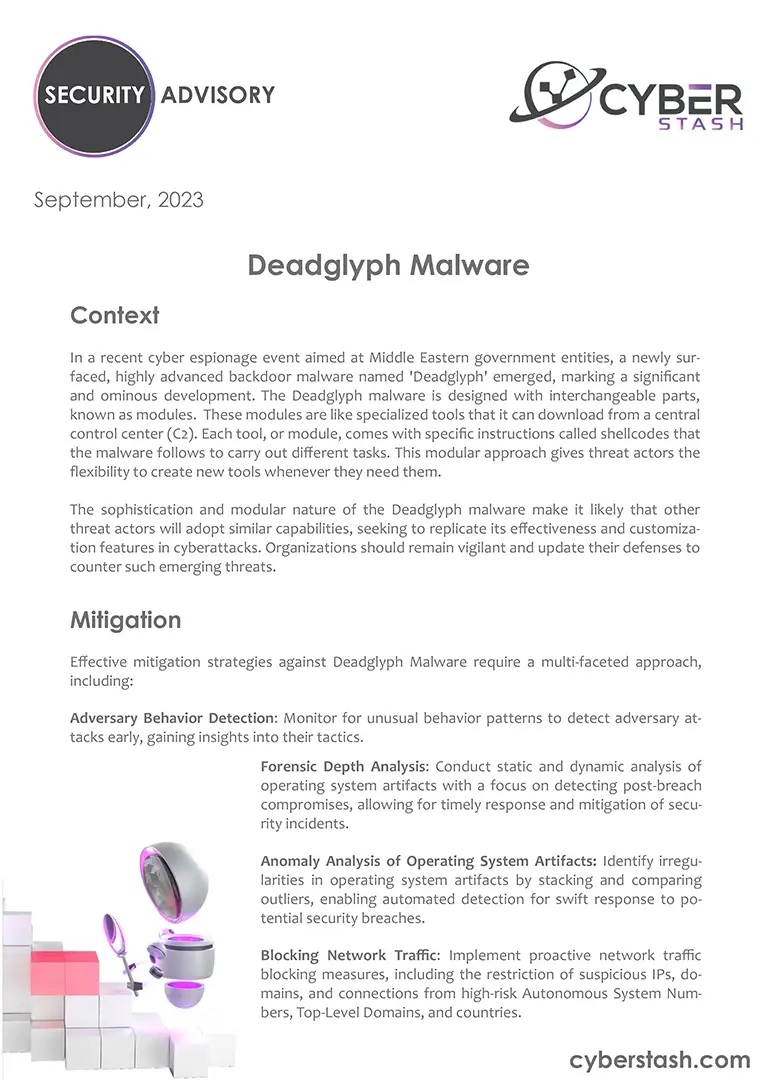
In a recent cyber espionage incident targeting the Middle Eastern Government entities, a newly emerged and highly sophisticated backdoor malware called ‘Deadglyph’ made its ominous debut.
The Deadglyph malware is designed with interchangeable parts, known as modules. These modules are like specialized tools that it can download from a central control center (C2). Each tool, or module, comes with specific instructions called shellcodes that the malware follows to carry out different tasks.
This modular approach gives threat actors the flexibility to create new tools whenever they need them. It’s like having a toolbox with the ability to craft custom tools for specific targets. These custom tools can then be sent to victims to carry out additional harmful actions.
Deep
Gosu
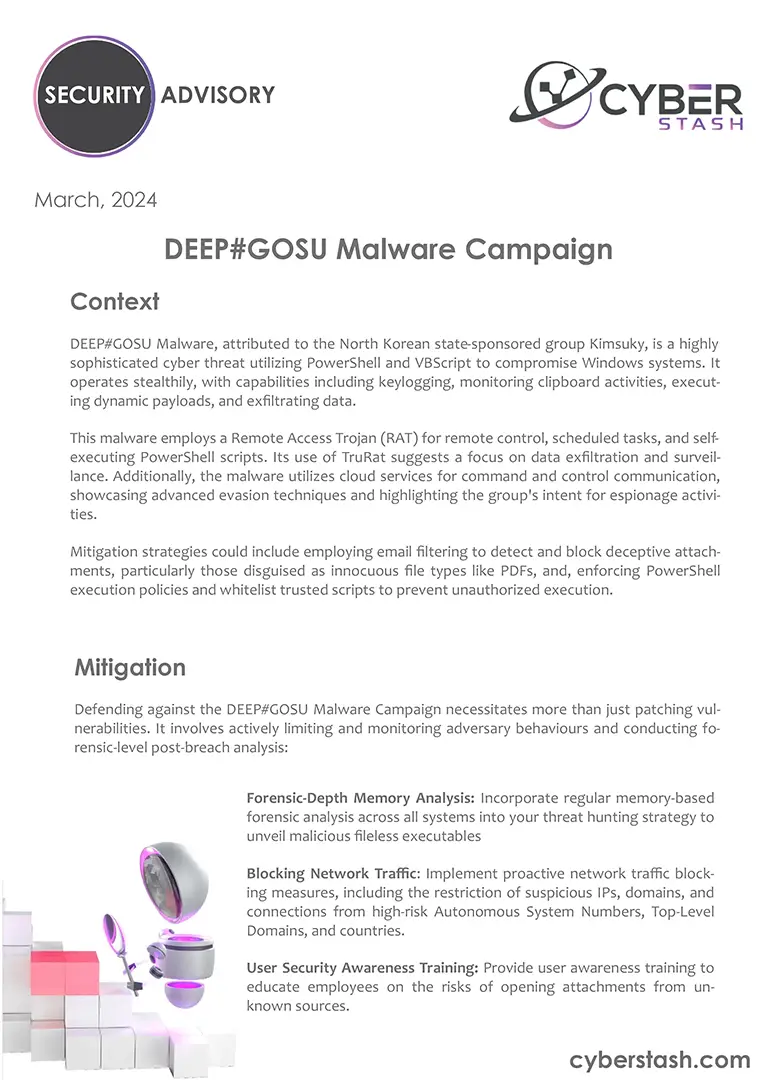
DEEP#GOSU Malware represents a highly sophisticated and elaborate cyber threat campaign observed recently, leveraging PowerShell and VBScript malware to compromise Windows systems. DEEP#GOSU malware is highly advanced and operates stealthily on Windows systems, especially when it comes to monitoring network activity.
Its abilities encompassed keylogging, monitoring clipboard activities, executing dynamic payloads, exfiltrating data, and maintaining persistence. This was achieved through a combination of Remote Access Trojan (RAT) software for complete remote control, scheduled tasks, and self-executing PowerShell scripts utilizing jobs.
Security Advisory -
DragonSpark
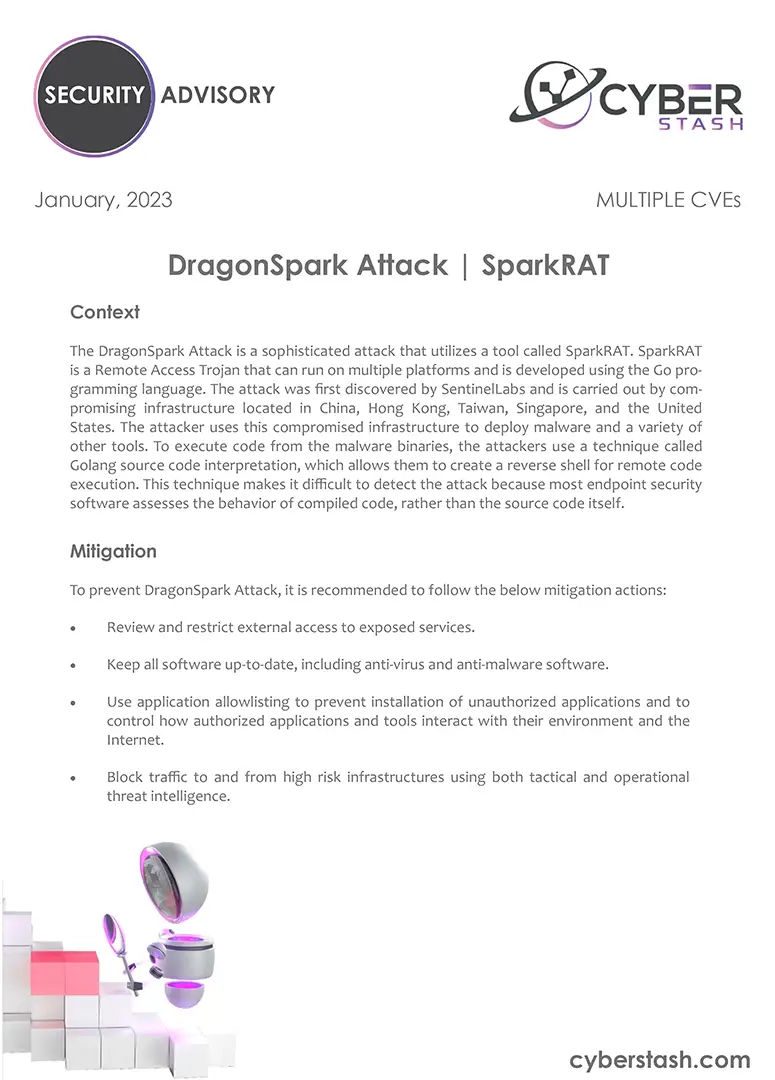
Exploiting
The regreSSHion Vulnerability
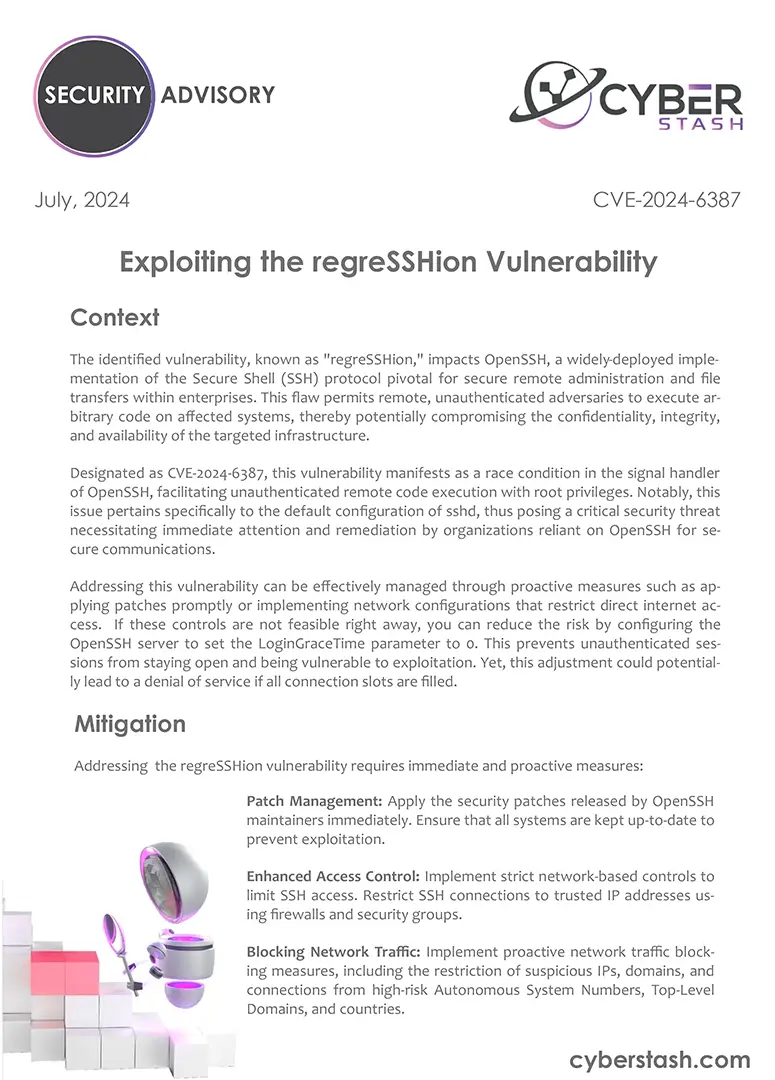
Emojis
Powered Malware Operations
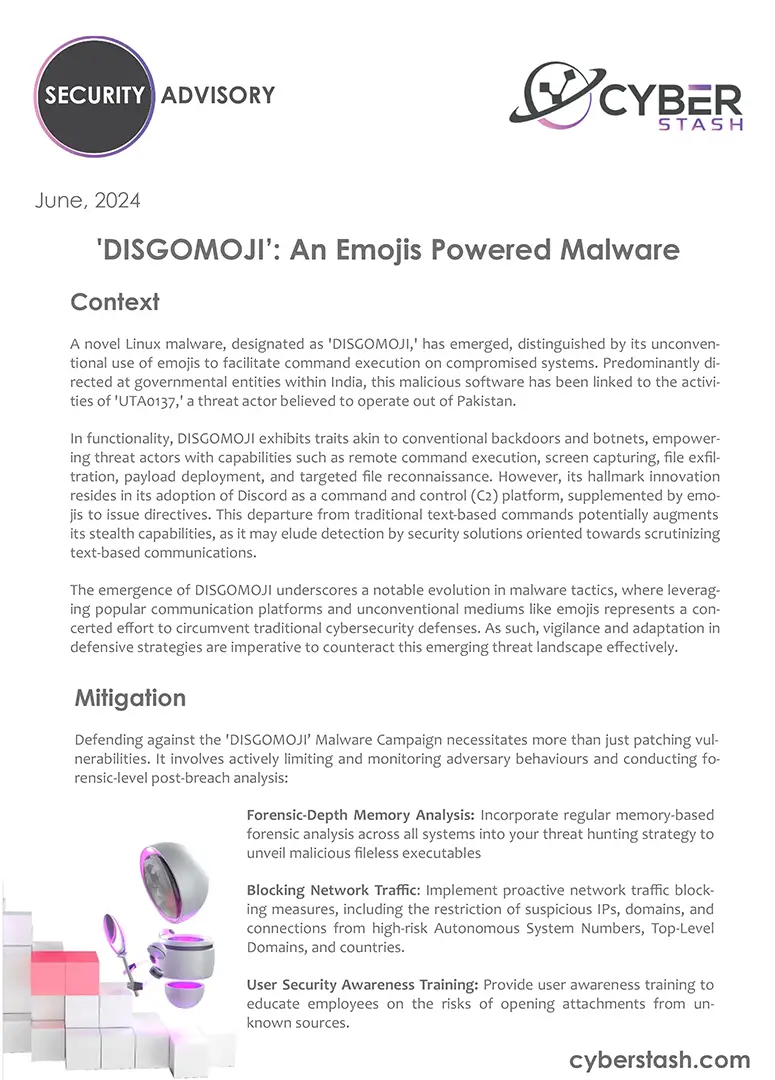
3CX
Desktop App Report

BellaCiao
IRGC

An Iranian state-sponsored hacking group known as APT35/APT42 or Mint Sandstorm has been identified as deploying a new strain of malware named BellaCiao, which has targeted victims in various countries, including the U.S., Europe, India, Turkey, and others. The campaign aims to exploit vulnerabilities in Microsoft Exchange servers to gain unauthorized access and deploy malicious payloads for espionage, data theft, and potentially ransomware attacks.
BellaCiao is a dropper malware designed to deliver additional malicious payloads to compromised devices based on instructions from the threat actors. Its primary objective is to establish persistence and maintain stealth while awaiting further instructions. The malware is customized for each victim (including hardcoded information such as company name, specially crafted subdomains, or associated public IP address) ensuring tailored implants and evading detection mechanisms.
BiBi
Wiper Malware

In a recent surge of cyber threats, Israeli computers are increasingly facing data-wiping attacks perpetrated by variants of the BiBi malware family. Researchers have identified these destructive elements affecting both Linux and Windows systems. The attacks are part of a broader cyber offensive targeting various sectors in Israel, notably in education and technology.
The Security Joes’ Incident Response team recently uncovered ‘BiBi-Linux,’ a malware strain designed for irreversible data corruption and operational disruption. Following this discovery, ESET researchers confirmed on October 31,2023 that a Windows variant of the same malware, linked to a hacktivist group named BiBiGun, was identified. This group is associated with Hamas, indicating a coordinated effort in deploying the malware for potential cyber-attacks and disruptions.
CMoon
USB Worm

Mint
Sandstorm Campaign
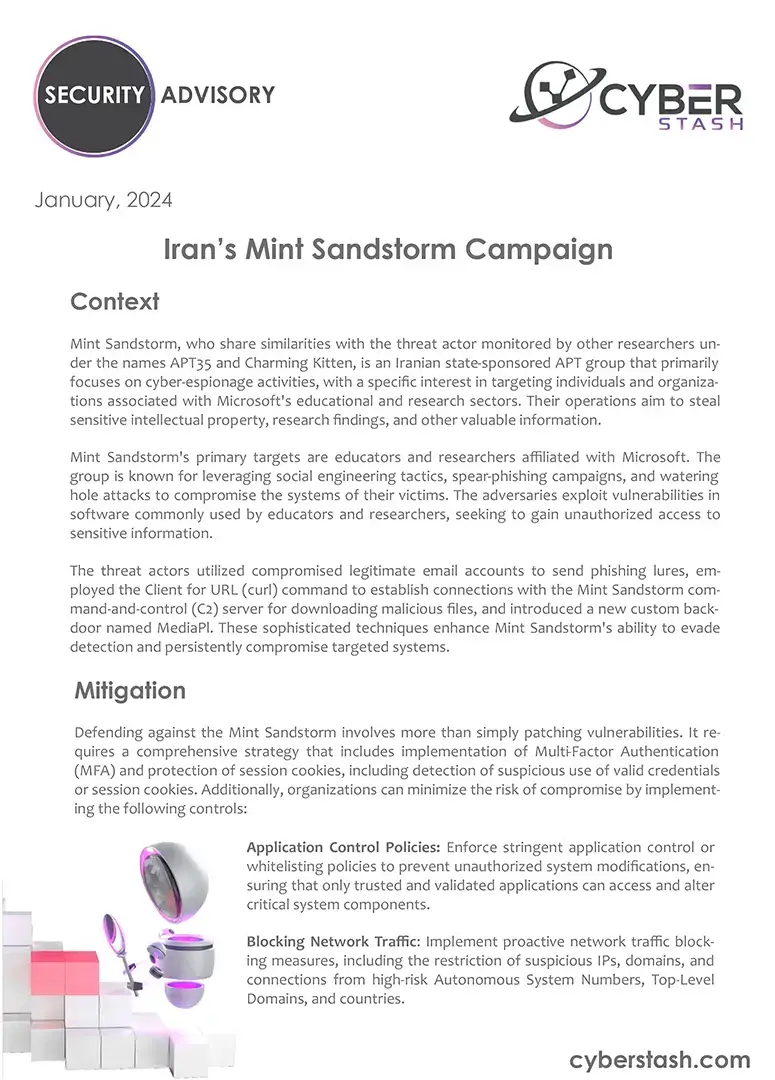
Security Advisory -
Nevada Ransomware
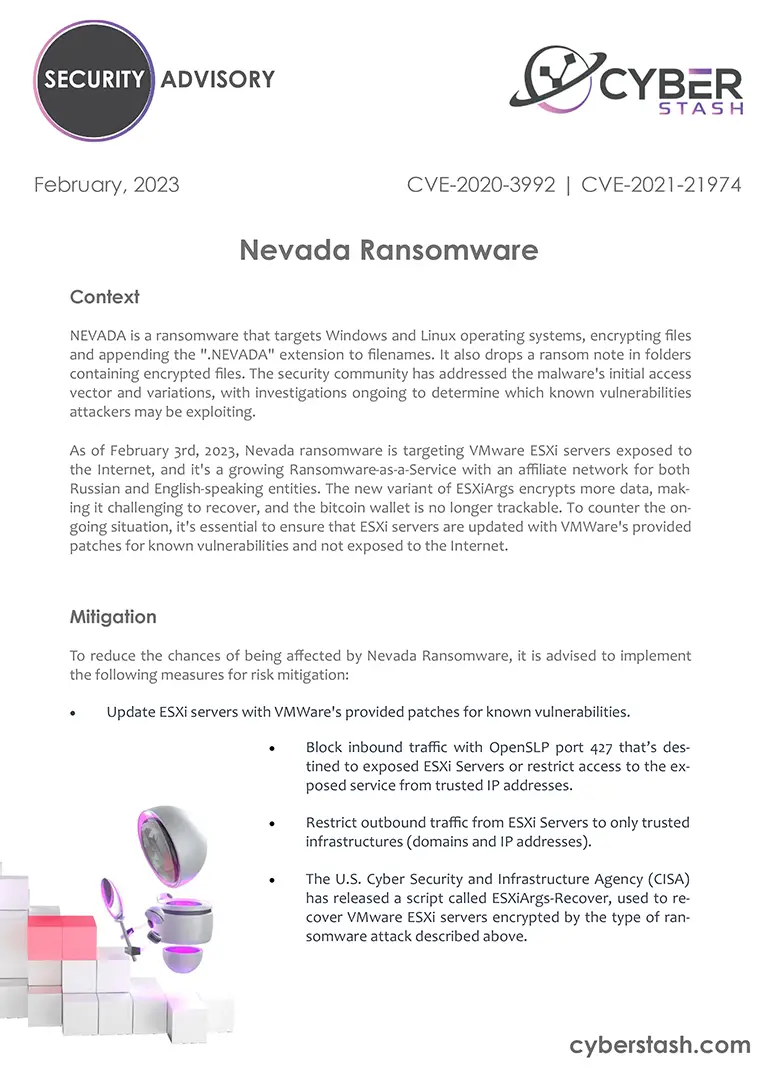
Quasar
RAT Stealthy DLL Side-Loading
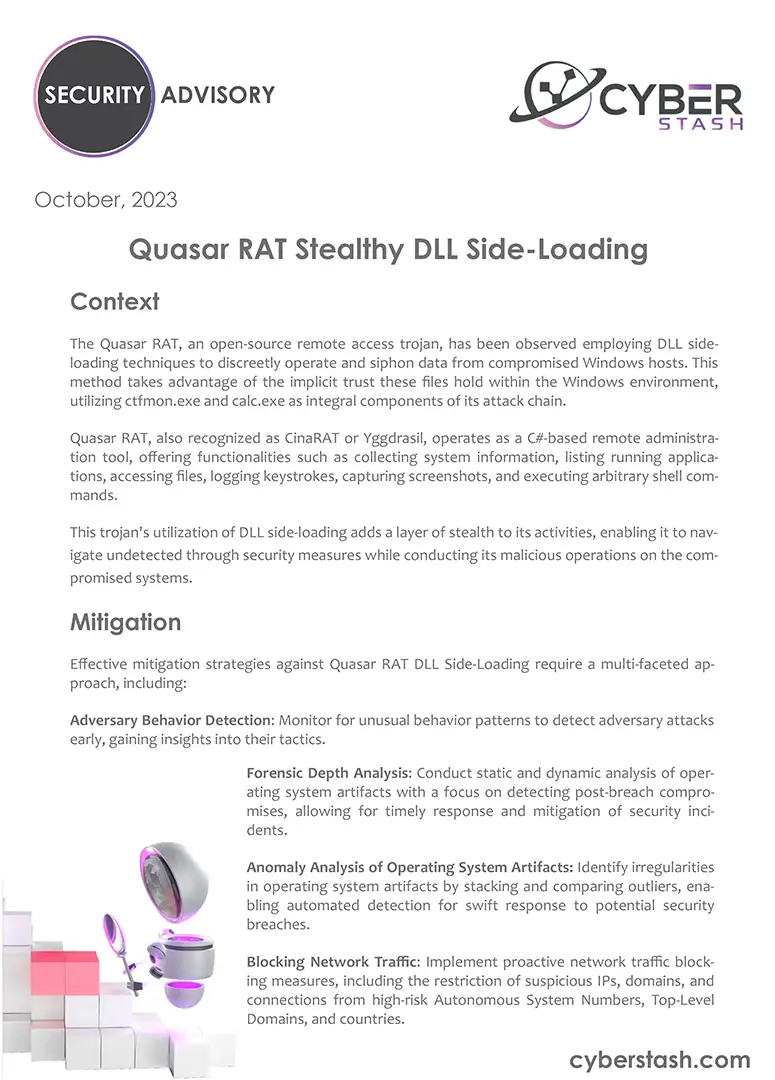
Remcos
RAT
